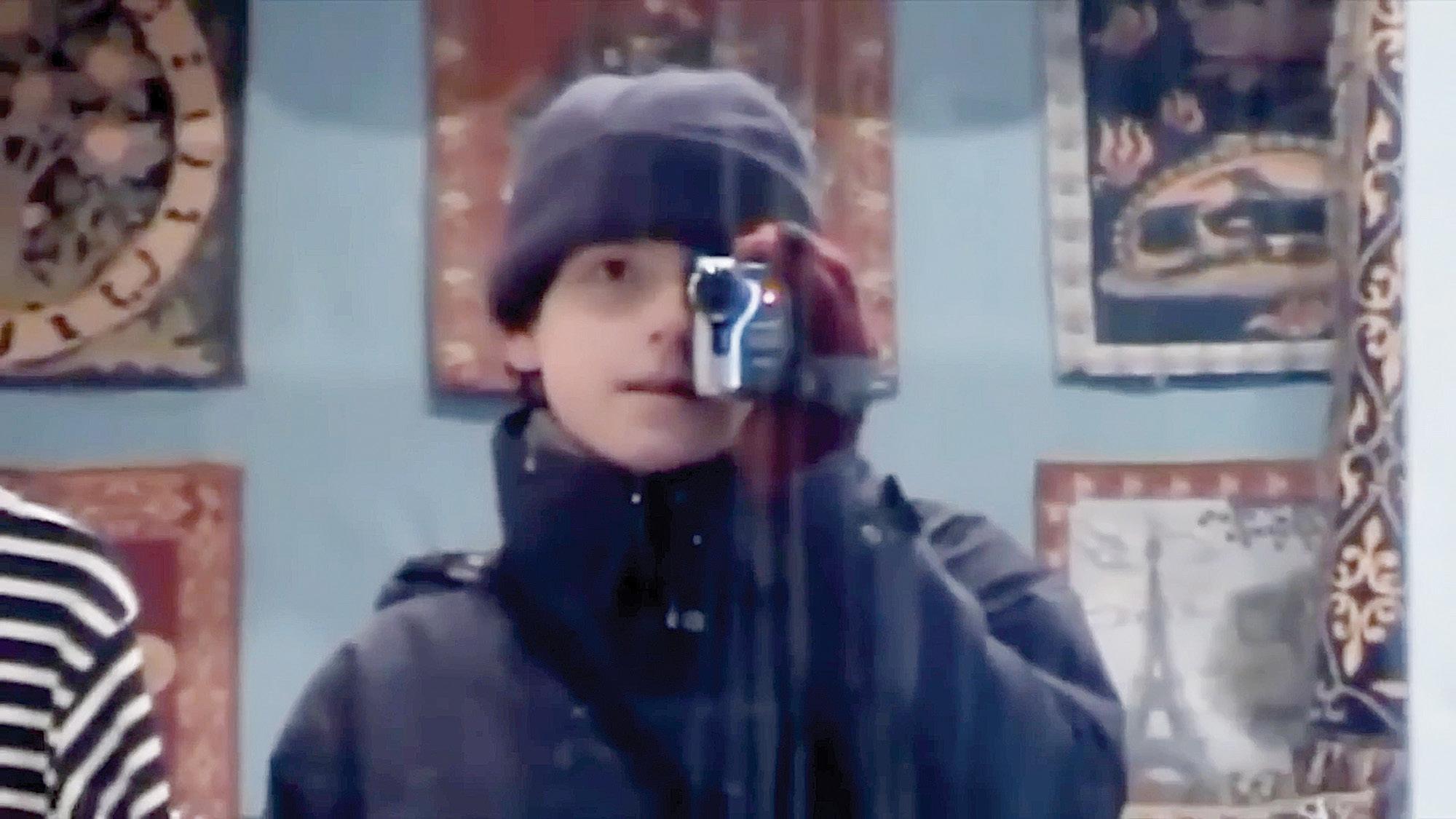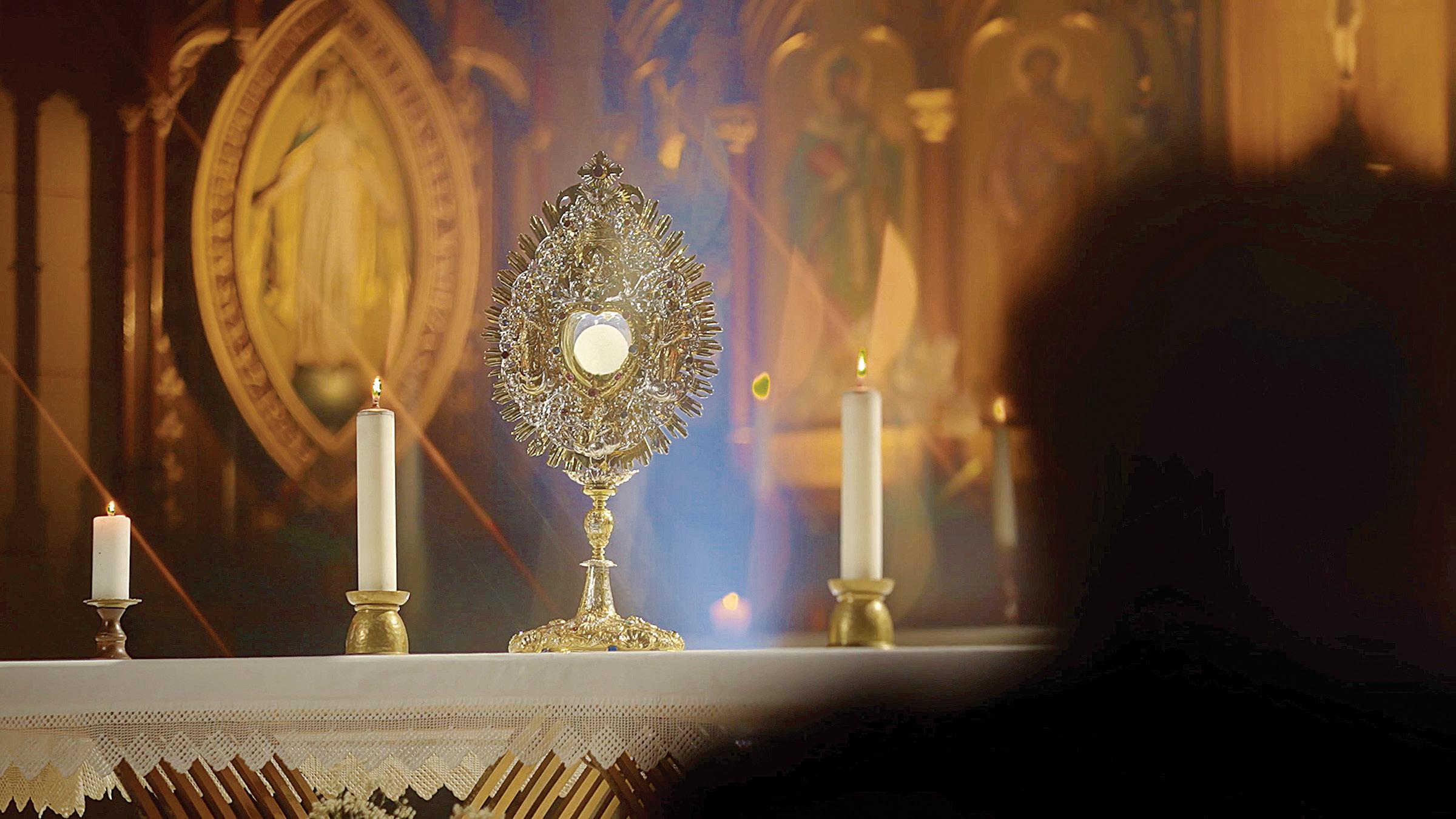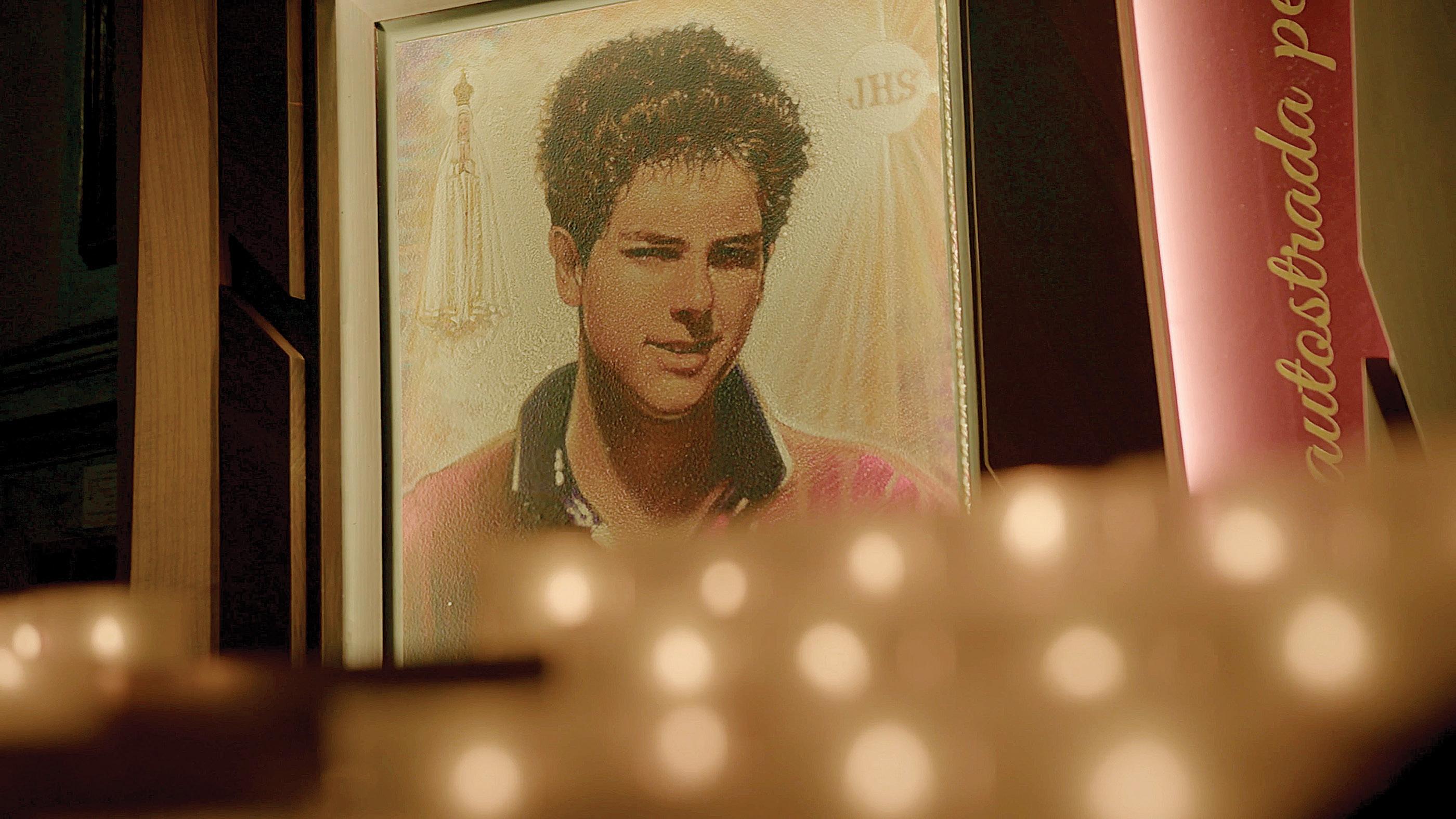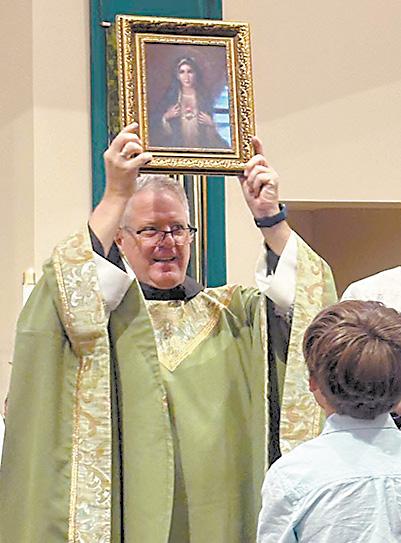




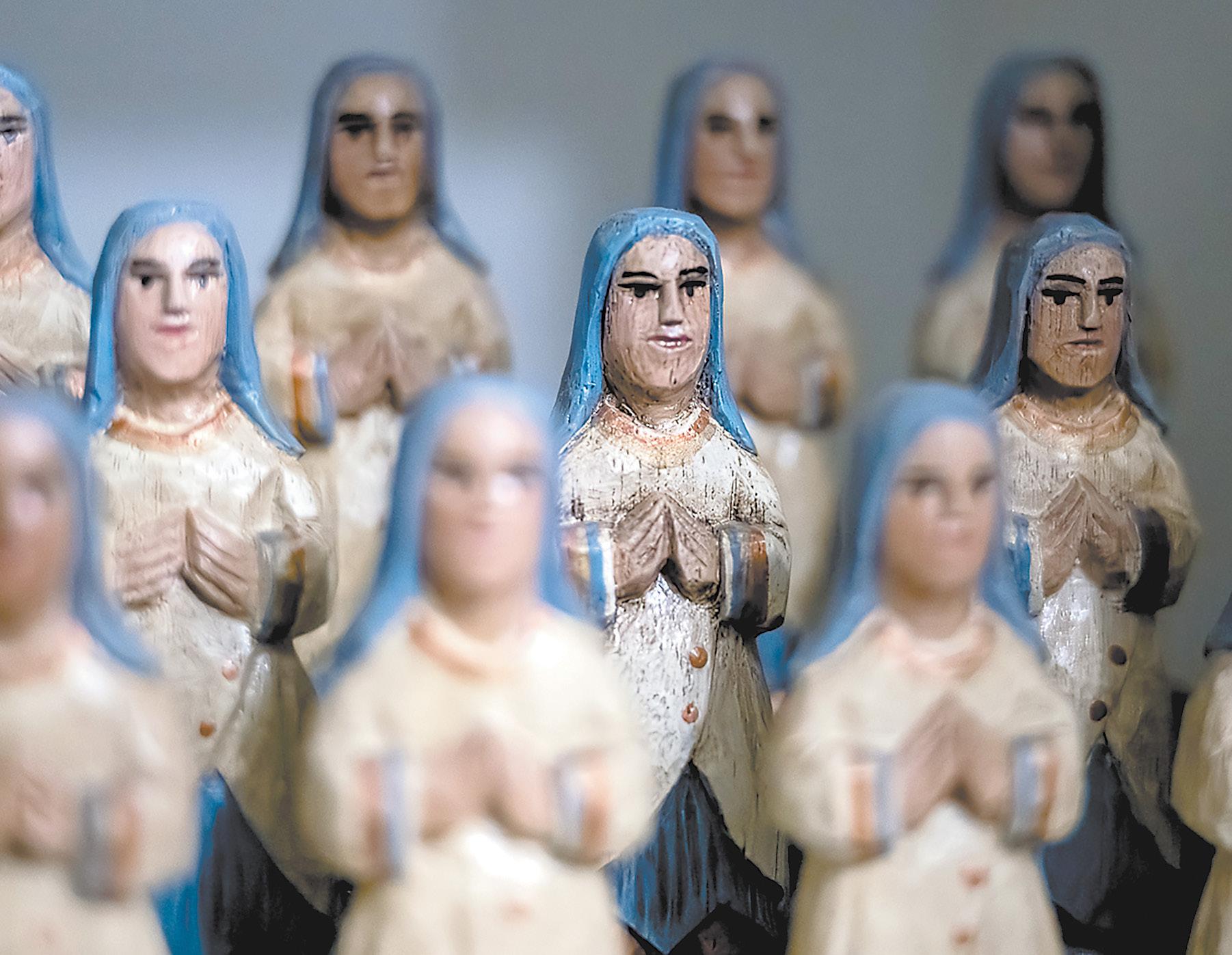















August 1, 2025
VOLUME 34 • NUMBER 21 1123 S. CHURCH ST.
CHARLOTTE, N.C. 28203-4003 catholicnews@rcdoc.org 704-370-3333
PUBLISHER
The Most Reverend
Michael T. Martin, OFM Conv., Bishop of Charlotte
Arts & Entertainment 10-11
Contact us 2
Español 15-16
Our Diocese 4-9
Our Faith 3
Scripture 3, 16
U.S. news 18-19
Viewpoints 22-23
World news 20-21
EDITOR: Trish Stukbauer 704-370-3392, tmstukbauer@rcdoc.org
ADVERTISING MANAGER: Kevin Eagan 704-370-3332, keeagan@rcdoc.org
MULTIMEDIA DESIGNER: David Puckett 704-808-4521, dwpuckett@rcdoc.org
EDITORIAL TEAM: Kimberly Bender 704-370-3394, kdbender@rcdoc.org Lisa Geraci 704-370-3294, lmgeraci@rcdoc.org
Troy C. Hull 704-370-3288, tchull@rcdoc.org
Christina Lee Knauss 704-370-0783, clknauss@rcdoc.org Brian Segovia 704-370-3235, bmsegovia@rcdoc.org
COMMUNICATIONS ASSISTANT/CIRCULATION: Amelia Kudela 704-370-3333, catholicnews@rcdoc.org
COMMUNICATIONS DIRECTOR: Liz Chandler 704-370-3336, lchandler@rcdoc.org
ASSISTANT COMMUNICATIONS DIRECTOR: Patricia L. Guilfoyle 704-370-3334, plguilfoyle@rcdoc.org
THE CATHOLIC NEWS HERALD is published by the Roman Catholic Diocese of Charlotte 26 times a year.
NEWS: The Catholic News Herald welcomes your news and photos. Please e-mail information, attaching photos in JPG format with a recommended resolution of 150 dpi or higher, to catholicnews@rcdoc.org All submitted items become the property of the Catholic News Herald and are subject to reuse, in whole or in part, in print, electronic formats and archives.
ADVERTISING: Reach 165,000 Catholics across western North Carolina! For advertising rates and information, contact Advertising Manager Kevin Eagan at 704-370-3332 or keeagan@rcdoc.org. The Catholic News Herald reserves the right to reject or cancel advertising for any reason, and does not recommend or guarantee any product, service or benefit claimed by our advertisers.
SUBSCRIPTIONS: $17.25 per year for registered families of the Diocese of Charlotte and $25 per year for all others
POSTMASTER: Periodicals Class postage (USPC 007-393) paid at Charlotte, N.C. Send address corrections to the Catholic News Herald, 1123 S. Church St., Charlotte, N.C. 28203.
Catholicismhas deep roots in Puerto Rico, a U.S. territory in the northeastern Caribbean Sea. The first diocese in the New World was authorized in Puerto Rico in 1504 but not officially launched due to the opposition of King Ferdinand of Spain, who didn’t want tithes to the diocese to take gold he believed was rightfully the crown’s. Today, between 75 and 85 percent of Puerto Rico’s population identifies as Roman Catholic, and their faith is a rich combination of elements of Spanish, Latin American and West African traditions.

Puerto Rican Catholicism emphasizes devotion to the saints – as seen in the santos de palo carvings on page 12. Traditionally, towns were centered around churches in Puerto Rico, and Spanish law mandated a plaza be built near the church to hold fiestas patronales (patron saint festivals). Today, these festivals may still include a procession, but they are broader cultural events that include parades, games, food and entertainment.
ESPAÑOL

VIÑEDO DE RAQUEL ¿Es usted o un ser querido que busca la curación de los efectos de un aborto anterior? Los retiros de fin de semana son ofrecidos por Caridades Católicas para hombres y mujeres en todas las regiones de la Diócesis de Charlotte. Para obtener información, comuníquese con Karina Hernández: 336-267-1937 o karinahernandez@live.com.
PRAYER SERVICES
MASS WITH ANOINTING OF THE SICK : 10 a.m. Saturday, Aug. 23, St. Luke Church, 9800 Fairview Road, Mint Hill. Anointing of the sick is available for those who need healing from physical or mental illness, or for someone who will be undergoing surgery. Sponsored by the parish’s HOPE Committee. For details, call Mary Adams at 704-545-1224. 25TH AND 50TH WEDDING ANNIVERSARY MASS : Bishop Michael Martin will celebrate the diocese’s annual Mass for couples commemorating their 25th or 50th wedding anniversaries at 3 p.m. Sunday, Oct. 26, at St. Patrick Cathedral in Charlotte, followed by a reception. Register at www.charlottediocese.org/form-wedding-anniversary-mass.
ST. PEREGRINE HEALING PRAYER SERVICE 7 p.m. every fourth Thursday of the month, St. Matthew Church chapel, 8015 Ballantyne Commons Pkwy., Charlotte. Includes a blessing with the relic of St. Peregrine. For details, go to www.stmatthewcatholic.org/st-peregrine.
EXPLORE THE OLDEST CHURCH
Founded in 1521, the Cathedral of San Juan Bautista is the oldest church on U.S. soil and the secondoldest church in the Western Hemisphere. The gothic structure built in 1529 is actually the second church on the site, since the original was destroyed by a storm. It contains the remains of the explorer and conquistador Juan Ponce de León, as well as those of the martyr St. Pius. It also houses some relics, such as the vestments worn by Pope John Paul II during his visit to Puerto Rico in 1984.
Scan the QR code for this week’s recommended prayers and activities:

Puerto Rican cooking is known for its flavorful combination of spices and oils mixed with staples like rice, beans and chicken. The simple recipes we’ve gathered online provide the perfect opportunity to bring kids into the kitchen and talk about the culture as you prepare a meal together.
— Catholic News Herald, Wikimedia and Catholic News Service

Bishop Michael Martin, OFM Conv., will participate in the following events over the coming weeks:
AUG. 10 – 11 A.M.
Mass for New Class of College Seminarians
St. Patrick Cathedral, Charlotte
AUG. 13 – 6 P.M.
Confirmation
Divine Redeemer Church, Boonville
Pastor Installation
St. John the Evangelist Church, Waynesville
AUG. 20 – 6 P.M.
Confirmation
St. John the Baptist Church, Tryon
DEACON MATTHEW NEWSOME catholicnews@rcdoc.org
Iwrote this just a few short days before I led a Jubilee Year pilgrimage to Rome and other shrines in Italy. That meant I had some packing to do. So naturally, I opted to write about packing as a means of procrastination.
My habit when I fly is to limit myself to one carry-on. This propensity to travel light grew out of my first experience backpacking. When I was newly out of college, a friend invited me to join him on a multi-day excursion in the Great Smoky Mountains National Park. It was my first time undertaking such an endeavor, and not knowing what to expect, I took the Boy Scout motto to heart: “Always be prepared.”
The problem was, I was no Boy Scout. Had I been, I would have known that being prepared has more to do with physical and mental readiness than strapping an entire general store to your back.
All those “just in case” items I carried through the mountains only weighed me down and wore me out. Rather than helping me along the way, they made the journey more difficult. Ever since then, I have been more judicious about what I take with me.
Packing lightly forces me to be more discerning about what is and isn’t necessary. Do I need a different outfit for every day of my trip, for example? The answer is no. Some things, like medications, are a must, but many other items are luxuries. I find it a useful challenge to see how much I can do without, especially when it’s only a matter of days.
Jesus imposed rather strict baggage limits for His missionary disciples: “Take nothing with you for your journey, no staff, nor bag, nor bread, nor money; and do not have two tunics” (Lk 9:3). The classic interpretation of this text is that Christ was teaching His apostles to rely on God, trusting that He would provide for them through the hospitality of others.
Later He instructs them, “Do not be anxious about your life, what you shall eat, nor about your body, what you shall put on. For life is more than food, and the body more than clothing. Consider the ravens: they neither sow nor reap, they have neither storehouse nor barn, and yet God feeds them. Of how much more value are you than the birds!” (Lk 12:22-24).

EDITOR’S NOTE
Following the practice of previous Holy Fathers, Pope Leo XIV is taking time off in July. His weekly general audiences – which provide the content for his column on this page – will resume in August. His column will return after that time.
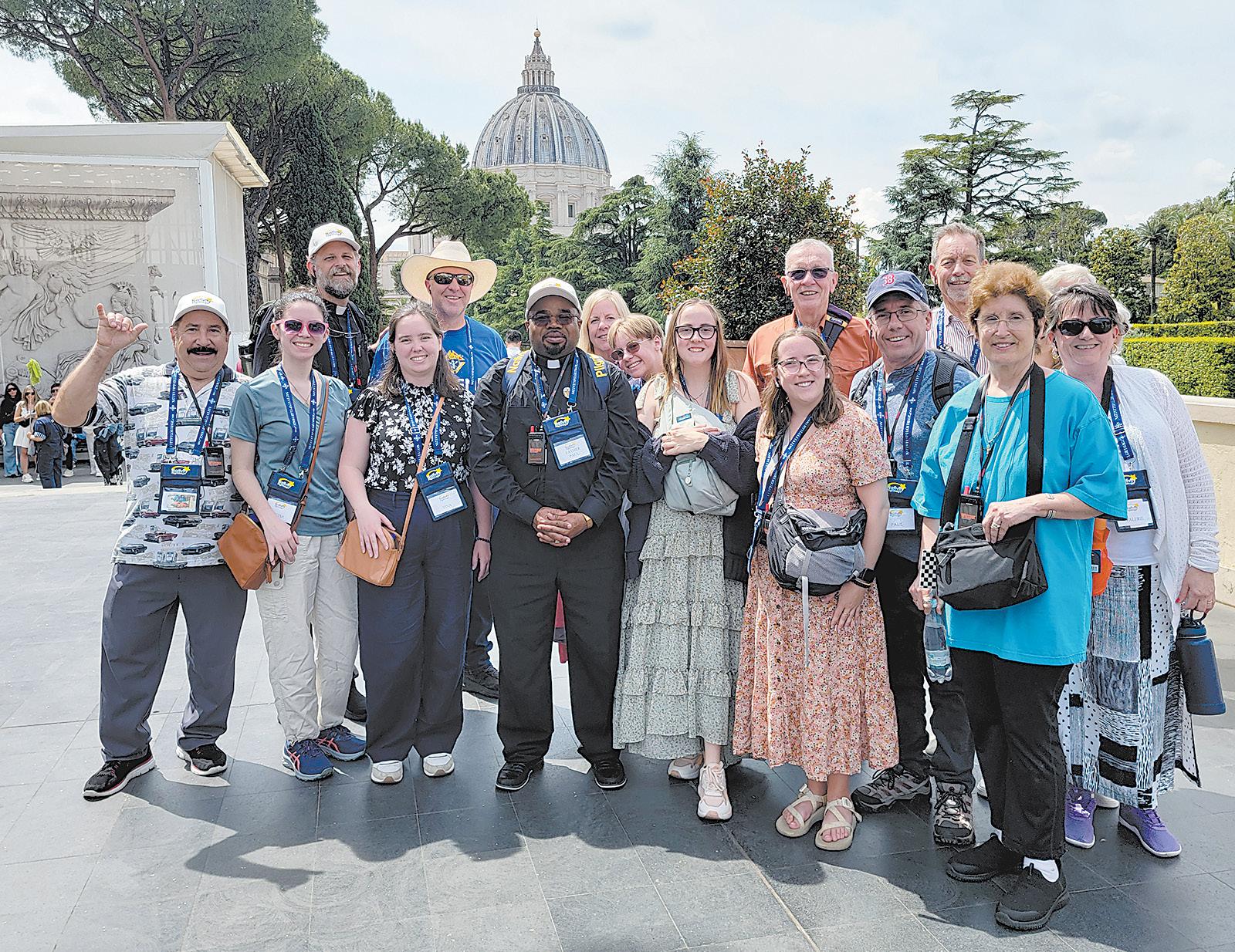

Deacon Matthew Newsome and pilgrims from Charlotte are pictured in Rome with the dome of St. Peter’s Basilica in the background. (Left) A young woman from the pilgrimage prays at the tombs of St. Benedict and St. Scholastica in Monte Cassino. What you pack – and choose to leave behind – can help shape your faith journeys, both physically and spiritually.
‘The prospect of letting go can be frightening, but learning to do so is a vital part of our pilgrimage.’
He imparts this wisdom after telling the parable of a rich man who builds larger and larger barns to store his surplus crops, thinking he would “eat, drink and be merry,” until God says to him, “Fool! This night your soul is required of you; and the things you have prepared, whose will they be?” (Lk 12:16-20). Jesus provides the moral of this
AUG. 3-9
Sunday: Eccl 1:2, 2:21-23, Ps 90:3-4, 5-6, 12-13, 14 and 17, Col 3:1-5, 9-11, Lk 12:13-21; Monday (Memorial of St. John Vianney, Priest): Num 11:4b-15, Ps 81:12-13, 14-15, 16-17, Mt 14:13-21; Tuesday: Num 12:1-13, Ps 51:3-4, 5-6ab, 6cd-7, 12-13, Mt 14:22-36; Wednesday (Feast of the Transfiguration of the Lord): Dan 7:9-10, 13-14, Ps 97:1-2, 5-6, 9, 2 Pt 1:16-19, Lk 9:28b-36; Thursday: Num 20:1-13, Ps 95:12, 6-7, 8-9, Mt 16:13-23; Friday (Memorial of St. Dominic, Priest): Deut 4:32-40, Ps 77:1213, 14-15, 16 and 21, Mt 16:24-28; Saturday: Deut 6:4-13, Ps 18:2-3a, 3bc-4, 47 and 51, Mt 17:14-20
parable up front: “Beware of covetousness; for a man’s life does not consist in the abundance of his possessions” (Lk 12:15).
As Job so poignantly observed, “Naked I came from my mother’s womb, and naked I shall return” (Jb 1:21). We all enter this world with nothing, and so shall we leave it. The wise Christian ought therefore to
AUG. 10-16
Sunday: Wis 18:6-9, 33:1, 12, 18-19, 20-22, Heb 11:1-2, 8-19 or Heb 11:1-2, 8-12, Lk 12:32-48 or Lk 12:35-40; Monday (Memorial of St. Clare, Virgin): Deut 10:12-22, 147:12-13, 14-15, 19-20, Mt 17:22-27; Tuesday: Deut 31:1-8, Deut 32:3-4ab, 7, 8, 9 and 12, Mt 18:1-5, 10, 1214; Wednesday: Deut 34:1-12, 66:1-3a, 5 and 8, 16-17, Mt 18:15-20; Thursday (Memorial of St. Maximilian Kolbe, Priest and Martyr): Jos 3:7-10a, 11, 13-17, 114:1-2, 3-4, 5-6, Mt 18:21–19:1; Friday (Solemnity of the Assumption of the Blessed Virgin Mary): Rev 11:19a, 12:1-6a, 10ab, 45:10, 11, 12, 16, 1 Cor 15:20-27, Lk 1:39-56; Saturday: Jos 24:14-29, 16:1-2a and 5, 7-8, 11, Mt 19:13-15
have a sense of detachment from the goods of this world, most of which cannot fit in an overhead compartment.
Learning to travel with only the bare necessities can help us not only learn to rely on God’s providence, but also teach us to receive His blessings with greater gratitude. Not being weighed down by either physical or spiritual baggage allows our hearts to soar more freely to the heights.
As the Church reminds us in this Jubilee Year of Hope, our time on earth is meant to be a pilgrimage to heaven. Most of the baggage we carry on life’s journey isn’t material. We carry around things like grudges, anger, hurt feelings, resentment, a sense of entitlement or self-righteousness. These are heavy burdens that only serve to weigh us down. Why do we cling to them so dearly?
We can grow so accustomed to carrying our personal baggage around with us that we forget who we are without it. The prospect of letting go can be frightening, but learning to do so is a vital part of our pilgrimage.
My earliest memories of packing are of preparing for weekend trips to my grandparents’ house. Mom and Dad would make sure we had the necessities, such as toothbrushes and clean clothes, while we children focused on packing toys and other diversions. Afraid of being bored, we wanted to bring as many playthings with us as we could. Of course, we were never bored at Grandma’s house. There were always cousins to play with, backyard adventures to be had and story books to read on Grandaddy’s lap. More often than not, we would forget all about our toys, leaving them packed away in our bags, untouched. All the things we thought we couldn’t live without proved to be unimportant once we reached our destination.
In the Father’s house, all our needs will be met. We needn’t worry about lacking a thing. Therefore, as we travel along our earthly pilgrimage, let us travel lightly, letting go of our burdens so that our hands and hearts may be open to receive all the blessings our Lord can give us. Godspeed to each of you along the journey.
DEACON MATTHEW NEWSOME is the Catholic campus minister at Western Carolina University and the author of “The Devout Life: A Modern Guide to Practical Holiness with St. Francis de Sales,” available from Sophia Institute Press.
AUG. 17-23
Sunday: Jer 38:4-6, 8-10, 40:2, 3, 4, 18, Heb 12:1-4, Lk 12:49-53; Monday: Judg 2:1119, 106:34-35, 36-37, 39-40, 43ab and 44, Mt 19:16-22; Tuesday: Judg 6:11-24a, 85:9, 11-12, 13-14, Mt 19:23-30; Wednesday (Memorial of St. Bernard, Abbot and Doctor of the Church): Judg 9:6-15, 21:2-3, 4-5, 6-7, Mt 20:1-16; Thursday (Memorial of St. Pius X, Pope): Judg 11:29-39a, 40:5, 7-8a, 8b-9, 10, Mt 22:1-14; Friday (Memorial of the Queenship of the Blessed Virgin Mary): Ru 1:1, 3-6, 14b-16, 22, 146:5-6ab, 6c-7, 8-9a, 9bc-10, Mt 22:34-40; Saturday: Ru 2:1-3, 8-11, 4:13-17, 128:1b-2, 3, 4, 5, Mt 23:1-12
For the latest news 24/7: catholicnewsherald.com
Go behind the scenes: Volunteer at 2025 Eucharistic
Calling all friendly faces to volunteer with the 2025 Diocese of Charlotte Eucharistic Congress, set for Sept. 5-6 at the Charlotte Convention Center. A variety of volunteer roles are available –including greeters, ushers, procession assistants, information booth attendants and book sales support. All volunteers receive free parking, and ushers and youth track volunteers also receive a free T-shirt. Learn more and sign up at www.goeucharist.com/get-involved.
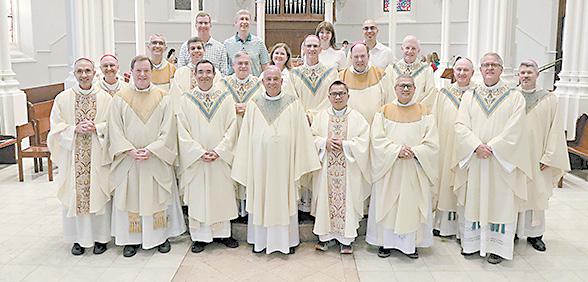
PHILADELPHIA — Bishop Michael Martin, OFM Conv., joined some of his brother bishops at Villanova University’s Center for Church Management Leadership Program for New Bishops at the end of July. Bishop Martin and 15 other bishops (pictured) attended a Mass celebrated by Philadelphia Archbishop Nelson Pérez at the University Chapel on July 22. — Sarah Webb, Archdiocese of Philadelphia Segovia joins Comms team
CHARLOTTE — Brian Segovia has joined the Diocese of Charlotte’s Communications Office as the Hispanic Media Coordinator to help inform and engage with the diocese’s growing Hispanic Catholic community.
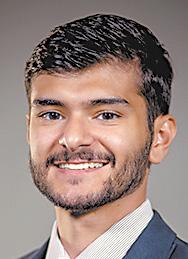
Segovia will produce and edit content in both Spanish and English for multiple communications channels including the Catholic News Herald’s award-winning print and digital platforms. He succeeds César Hurtado, who recently retired after 11 years in the role.
Segovia most recently worked as a multimedia journalist with Univision 40 North Carolina, where he produced television news for the Spanish-speaking population of the Raleigh metropolitan area. He previously interned at the Charlotte Business Journal and Fox Sports. Born in Lexington, Segovia is the son of Argentinian immigrants and grew up in the Charlotte area. He graduated from Charlotte Christian School and earned a bachelor’s degree in Journalism and International/Global Studies from Elon University.
“As our Hispanic Catholic community continues to grow across the diocese, it’s essential that our communications reflect, engage and serve these individuals and families,” said Liz Chandler, diocesan communications director. “Brian’s passion for storytelling in both English and Spanish will help us deepen those connections and ensure that everyone feels informed, included and inspired in their faith.”
— Catholic New Herald

‘We are called to be bearers of
LISA M. GERACI lmgeraci@rcdoc.org
HIGH POINT — A Vigil Mass celebrating the Jubilee Year of Hope at Immaculate Heart of Mary Church was packed July 19 as parishioners from across the Triad gathered to hear a hopeful message delivered by Bishop Michael Martin.
“All of us are called to be bearers of hope,” Bishop Martin said. “A whole year of hope has so much capacity in our world, in our country, in our diocese, in our parish and in your hearts.”
The Mass was put into motion months ago by Immaculate Heart of Mary’s pastoral council. As pastor, Father Patrick O’Connor felt his flock, which has recently experienced tremendous growth in both diversity and membership, could use a little hope.
“Within our Hispanic community, there has been so much anxiety, stress, worry, doubt and fear,” said Father O’Connor. “It is a good year to have a year of hope, to trust God is there in the midst of all this craziness and these difficulties. He is working. He is helping us through the Church, and He is with us in our suffering.”
Bishop Martin opened his homily with both good and bad news.
“The good news is that Jesus Christ has saved all of us – in this life and for the life to come,” he said. “Don’t ever forget it. Remind yourself of it regularly and proclaim it to the world that only knows the news they scroll through.
“The bad news is He doesn’t force it on any of us – leaving us the freedom of living life as we choose. We don’t freely accept this gracious gift of salvation enough, and too often we pursue other ways of being saved that never deliver.”
During the day’s Gospel reading from Luke that highlights Jesus’ friends, sisters Martha and Mary, the bishop said the two set a great example of hope. He warned that instead of pitting their two methods of adoration – hospitality and awe – against one another, it is important to practice both.
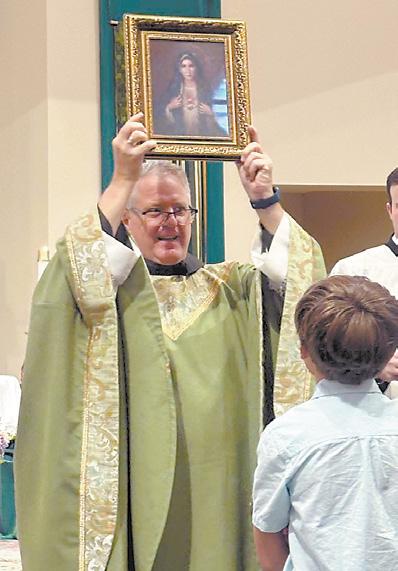
“Our Gospel today gives us two paradigms and two ways to respond to the saving hope of Jesus Christ,” he said.
“Martha’s message of hospitality should not be only exhibited in our homes but within our Church,” said Bishop Martin.
“Are you pouring (that hospitality) into the people that are crowding around you?
Sitting next to you? Especially within a parish that over the last 25 years has gotten so much more diverse.”
And while “Marthas” feed you, the bishop joked, sometimes we need to act a little more like Mary.
“We need to receive that message from Mary that calls us to sit with the cross and ponder His suffering. When we do that, that is when we bring a message of hope to the world,” he said.
“We live in a world that does not understand the redemptive capacity of suffering,” he continued. “Our crazy message of hope is to embrace the cross. You can only embrace it when you are part of it and contemplate it.”
Parishioner Fidencio Martinez, who
has been rehearsing with the choir for months in preparation for the special Mass, said the bishop’s homily was perfectly timed.
“I needed, we needed, to hear this message he has sent us, at this exact moment,” Martinez said. “We have all this fear. The politics of what is going on right now are scary, but I think his message is pretty clear: Have hope. He gets it.”
The message resonated with the diverse parish. “We have a lot of Filipinos, Indians, Hispanics, Africans and Vietnamese,” Father O’Connor said. “It’s really developed into quite a beautiful community representing so many cultures and nations throughout the world.”
After Mass, Father O’Connor was all smiles as he presented Bishop Martin with a gift from the parish: an image of the Immaculate Heart of Mary. Bishop Martin greeted a long line of parishioners, while members of the Hispanic community, taking inspiration from Martha, fed the crowd with a delicious buffet.
CHRISTINA LEE KNAUSS clknauss@rcdoc.org
CHARLOTTE — Natural Family Planning Awareness Week was July 20-26, and NFP leaders in the Diocese of Charlotte are actively promoting an approach that focuses on a woman’s overall health to help couples plan their families according to Catholic teaching.
It’s an approach called restorative reproductive medicine, which helps women – and men – understand the importance of caring for health and fertility well before couples begin trying to have children. It uses natural methods to help women identify and address problems that affect their fertility.
“Restorative reproductive medicine aims to correct the problem of infertility by finding the root cause and looking for a long-term fix through comprehensive healing,” explained Batrice Adcock, Natural Family Planning program director for the diocese’s Family Life Office. “The approach can help restore and improve a woman’s overall health as well as fertility.”
“Natural Family Planning Awareness Week is an invitation to reflect on the beauty of God’s design for marriage and the gift of fertility. God is the author of marriage and the Creator of our bodies, and His plan, made known to us by the teaching of the Catholic Church, is the best plan for finding happiness, holiness and fruitfulness in marriage,” Adcock said. “Natural Family Planning helps a couple cooperate with the design of their bodies
while embracing responsible parenthood, and so it is no surprise that this practice also unlocks valuable information that supports women’s health.”
Health care and fertility care professionals from the Charlotte diocese were able to learn more about this approach at the 44th annual meeting of the American Academy of Fertility Care Professionals held July 16-19 at Hilton Charlotte University Place.
The conference drew more than 150 fertility care professionals from around the U.S. as well as some who traveled from African nations, Australia and Canada.
A key aspect of the restorative reproductive approach they discussed was early identification and prevention of problems with a woman’s cycle or fertility.
“The Natural Family Planning approach touches on so much more than just helping to plan pregnancy,” Adcock said. “It can be a health and wellness tool for women at all stages.”
One tool Adcock promotes is Cycle Prep, a program for mothers and daughters (ages 9-12) that helps the girls transitioning through puberty to learn how to achieve healthy menstrual cycles and hormone balance. Another program, TeenFEMM, has similar goals for older teens.
“As girls learn to value their cycles, they often come to value their bodies more and take better care of themselves,” Adcock said. “This translates into improved health and future fertility. As they continue down the body literacy trajectory, they learn to track their cycles, and then later on,

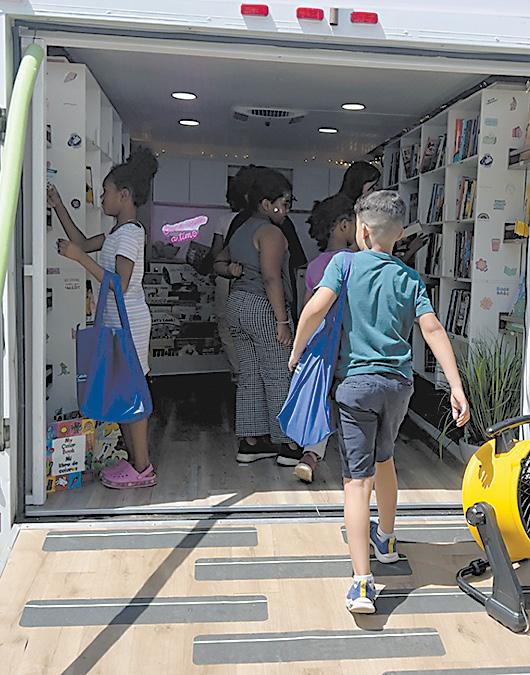
CHARLOTTE — Catholic Charities Diocese of Charlotte celebrated World Refugee Day June 20 with fun activities and giveaways for young and old alike. Participants, resettled to the U.S. in partnership with federal government, walked away with toys, activity books, personal and household products, and nonperishable foods. Children got to visit a book mobile and enjoyed an ice cream truck, face painting, soccer and games. Elite Touch Cleaning Services sponsored the ice cream truck and the face-painting booth. “These families have been through so much turmoil, fleeing war and other violence in their homelands,” said refugee resettlement director Laura Jones, “that it’s meaningful to Catholic Charities to be able provide a little relief, as Jesus asks of everyone.”
PHOTO PROVIDED
Natural Family Planning instructors often can pick up on problematic patterns that may point to hormone imbalance, and a referral to a doctor trained in restorative reproductive medicine can be made.”

Through four days of conference workshops, professionals learned about all facets of Natural Family Planning. Sessions encouraged them to take into account many factors that can affect a couple’s health and fertility, including spiritual and mental health as well as physical wellbeing. During the conference’s main session on July 19, for instance, Charlotte area counselor Christine Wisdom led a workshop about helping couples dealing with trauma and the impact trauma can have on fertility.
The importance of helping women learn about the natural gift of fertility and how to manage it was the focus of a keynote speech by Leah Jacobson, mother of eight, author of the book “Wholistic Feminism” and founder of the Guiding Star Centers. This growing nationwide network of centers offers pregnancy support, breastfeeding help, fertility education, drop-in child care and more to create safe havens that uphold human dignity in all stages of life.
Jacobson told attendees that their work in promoting Natural Family Planning was more important than ever in a cultural
landscape that is increasingly hostile to natural approaches to family planning and women’s healthcare, as well as to the gender roles and plans for the family that are part of God’s plan.
“Women’s healthcare should seek to support the natural functions of a female body – its feminine abilities to ovulate, gestate and lactate,” Jacobson said. “We need to help women understand who God made them to be and tell every woman and girl that she is good the way God made her.”
Natural Family Planning Week offers the chance to learn more about the physical and spiritual aspects of family planning according to Church teaching, said Father Peter Ascik, director of the Family Life Office.
“This week is an invitation to reflect on the beauty of God’s design for marriage and the gift of fertility,” Father Ascik said. “God is the author of marriage and the Creator of our bodies, and His plan, made known to us by the teaching of the Church, is the best plan for finding happiness, holiness and fruitfulness in marriage.
Natural Family Planning helps a couple cooperate with the design of their bodies while embracing responsible parenthood, and so it is no surprise that this practice also unlocks valuable information that supports women’s health.”
Learn more

At www.charlottediocese.org/faith-life/ family-life/natural-family-planning : Get more information on family planning education programs in the Diocese of Charlotte
ROCKVILLE, Md. — Members of Our Lady of Consolation Parish’s Ladies Auxiliary of the Knights of Peter Claver, a newer court, found invaluable opportunities for growth at the organization’s recent national convention. They delved into sessions on finances and the “state of our nation,” which included a powerful social justice rally led by U.S. Rep. Emanuel Cleaver II. Cleaver’s poignant quote from Thomas Paine, “These are the times that try men’s souls,” resonated deeply, leaving the OLC group encouraged and reaffirmed in their commitment to service.
The Knights of Peter Claver was founded in 1909 by four Josephite priests and three laymen from the Diocese of Mobile, Ala., who wanted to form a Catholic fraternal order for the African American community because the Church’s other orders at the time did not accept Black members. It expanded in 1926 to include a ladies auxiliary. Named for a 17th-century Spanish Jesuit priest who ministered to enslaved people, the New Orleansbased order has more than 400 chapters in the U.S.

LINVILLE — Members of Knights of Columbus Council 10389 from Holy Spirit Parish in Denver attended the annual parish picnic for St. Lucien Parish in Spruce Pine and St. Bernadette Mission in Linville in late June and delivered a check for more than $16,000 for ongoing relief in the wake of Tropical Storm Helene. The funds came from donations made by parishioners and were part of the Knights’ months-long effort to help storm victims in hard-hit areas of western North Carolina. It is the largest single response undertaken by Holy Spirit Parish and Council 10389. Relief efforts started within hours after the storm and began with member Knights using their personal vehicles to transport materials for airdrops out of Lincoln County Airport. Since then, Knights have made 15 trips to Boone and Jefferson as well as the small communities of Creston and Glendale Springs to drop off supplies ranging from food, toiletries and diapers to heaters, fuel, building supplies and chainsaws. In addition to offering assistance through the diocese’s Sister Parish Program, Holy Spirit parishioners organized special collections and raised money through a “Helene Helper” spaghetti dinner.
PHOTO PROVIDED
CHARLOTTE — August is Make-a-Will Month, a national initiative encouraging people to focus on something profoundly important: creating or updating their will.
“More and more people are creating wills because they do not trust state laws to determine how their assets will be divided,” said Jim Kelley, diocesan development director.
While a will determines who inherits your money and property, they also do more. With a will, you can nominate guardians for your minor children, name caretakers for your pets, leave instructions for digital assets, specify your funeral arrangements and more. A will is essential at any age. It provides clear, final instructions for your family and loved ones, helping ease what is often a difficult and confusing time.
A will is not just for the wealthy or the elderly – everyone needs one. If you or a loved one dies without a will, your assets could be distributed according to state laws and not according to your wishes.
Moreover, a will is a wonderful opportunity to leave an impactful legacy by creating detailed directives to support your local parish, school, ministries such as Catholic Charities, the diocese or the diocesan foundation.
“We are receiving phone calls every week from parishioners who are looking for a way to support the Church in their estate plans, because the Church has been such an important part of their life that they want to leave a portion of assets to continue its work after they are gone,” Kelley said.
The Diocese of Charlotte offers several planned giving options, including bequests, endowments, gifts of securities and real estate, life insurance, beneficiary designations and other options to fit your financial situation and wishes. The diocese’s Planned Giving staff can explain your options, answer any questions and discuss next steps.
Already have a will? Be sure to review it frequently. Life changes quickly, and your desires and directives now might differ from your original wishes. Writing or updating a will can be easy and affordable. Consult with a local attorney to ensure that the will you create is legally binding in your state, get it properly notarized, and give a copy to your loved ones so they have it when the need arises.
Make-a-Will Month is the perfect time to create or revise your will and leave a lasting legacy. The plans you make today will ensure a bright future for generations to come.
— Courtney McLaughlin

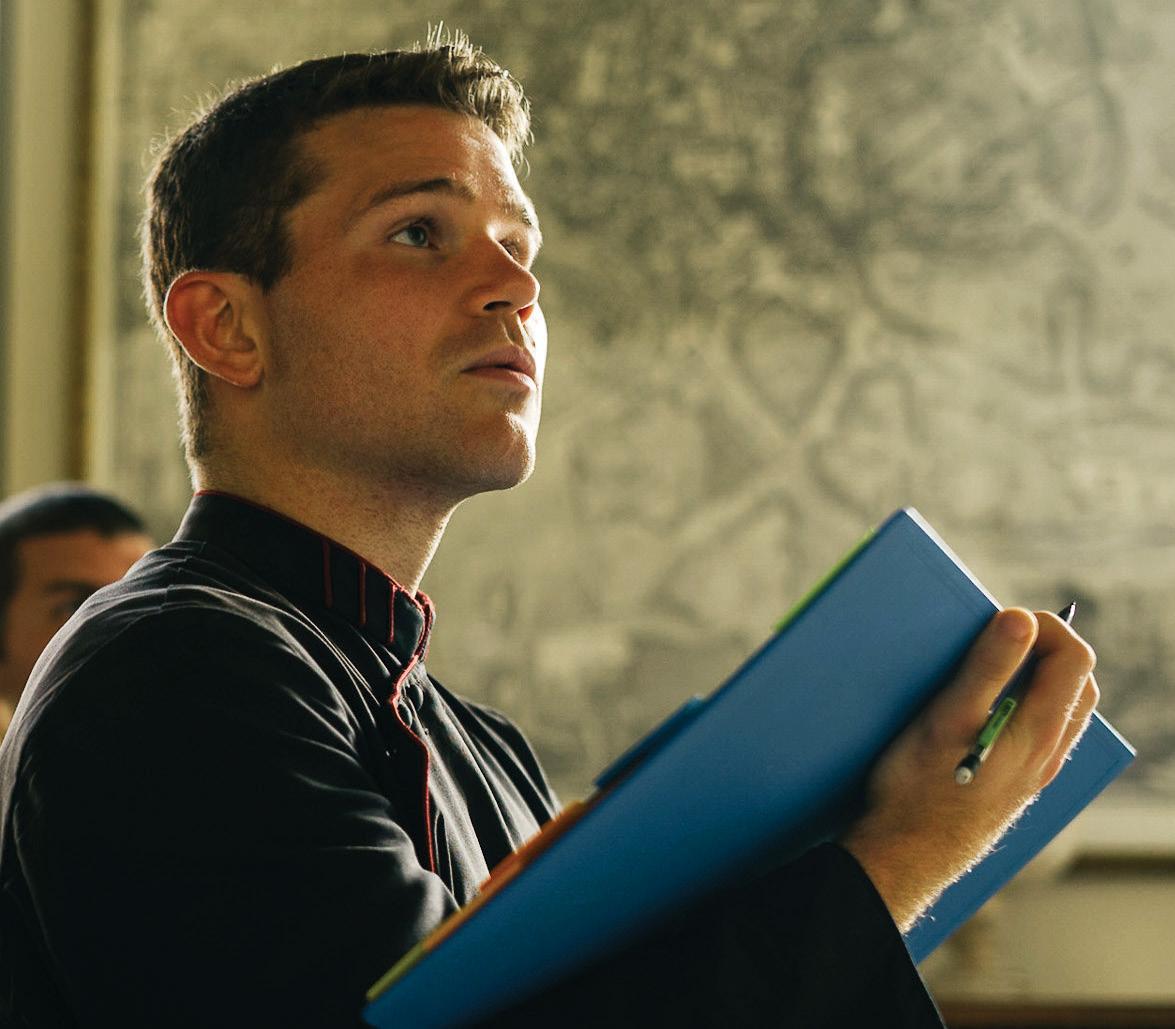


Learn more and sign up at www.carolinacamino.org
Learn more about the Jubilee Year of Hope and what you can do to join in the celebrations at www. charlottediocese.org/jubilee-2025
LISA M. GERACI lmgeraci@rcdoc.org
CHARLOTTE — Calling all 2025 Pilgrims of Hope! Have you ever wanted to hike the Camino de Santiago but were short of funds, time or energy? This year, put the excuses aside, because the experience will be available locally through the first 10-day hike of its kind: the Carolina Camino.
The Carolina Camino pilgrimage is modeled after the experiences Melinda and James Osborne, parishioners at Sacred Heart in Salisbury, had during their adventure on the Camino de Santiago – the famous Way of St. James. They journeyed through the countryside of Portugal and Spain, traveling a portion of the historical route that more than 400,000 pilgrims trek each year to reach the burial site of St. James the Apostle in Santiago de Compostela, Spain.
“We had such a spiritual awakening on the Camino de Santiago that we wanted to build a similar spiritual experience for people that are not able to travel overseas, people from North Carolina and South Carolina who want to do this and do it locally,” said James Osborne. “When you are walking, you have time to let your mind spiritually wander and meditate on God. It is life changing.”
The pilgrimage will start Tuesday, Aug. 26, at St. Lawrence Basilica in Asheville and will end at St. Patrick Cathedral in Charlotte on Friday, Sept. 5 – just enough time to take off those hiking boots, grab a shower, and journey over to the 2025 Diocese of Charlotte Eucharistic Congress. The basilica and the cathedral are official diocesan pilgrimage destinations during the 2025 Jubilee Year of Hope.
Destinations along the Carolina Camino include the monastery of the Queen of Peace Benedictine Sisters in Rutherford, Immaculate Conception Church in Forest City, St. Mary Help of Christians Church in Shelby, and Belmont Abbey Monastery and its Mary Help of Christians Basilica in Belmont (another official diocesan jubilee pilgrimage destination).
Pilgrims will walk an estimated 14.5 miles daily, with some days longer than others.
For those wondering if they are physically capable of making the 145mile journey, there will be a support van following with suitcases and supplies that can assist stragglers who need respite.
All proceeds from entry fees of $499.99 per person will go to Catholic Charities Diocese of Charlotte to support people devastated by Tropical Storm Helene.



Abundant amenities and a unique way of life
e Pennybyrn lifestyle is packed with amenities. Living here, you’ll swim laps in a stunning, indoor heated saltwater pool, stay t in a well-equipped facility and power walk, bike or stroll along scenic walking trails. Even membership at Jamestown Park Golf Course is included!
ere’s also the Pennybyrn di erence… and this is what truly sets us apart. You’ll nd a lovely Peace Chapel, a not-for-pro t mission to serve all faiths,
a smaller population for personalized service and inclusiveness that means your voice will always be heard.
A thoughtfully designed home
Your private residence at Pennybyrn—chosen from among a variety of oor plans and prices— will feature a bright, open design with plenty of natural light, a well equipped, modern kitchen, washer and dryer, high ceilings and a private porch, balcony or patio.
Most cottages include an attached garage or carport, and many o er a cozy replace.
Inspiring lifestyle choices
In a friendly neighborhood, and among sociable friends, you’ll explore a wealth of programs that are planned and shaped by fellow residents. Quiet times will nd you gathering in beautiful outdoor areas and inviting indoor spaces— including world-class dining choices and a true Irish Pub.
Our purpose at Pennybyrn is to make sure that your vibrant lifestyle is enjoyed with the lifelong support, assurance and bene ts of a Life Plan Community.


After packing hundreds of thousands of meals and other supplies during their annual Monsignor McSweeney World Hunger Drive each summer, St. Matthew parishioners box up everything, pray over their work, then load multiple shipping containers that are sent abroad to help people in need.
LISA M. GERACI lmgeraci@rcdoc.org
CHARLOTTE — St. Matthew Parish’s 23rd annual Monsignor McSweeney World Hunger Drive is in full swing, and everyone is invited to participate.
Over the past 22 years, parishioners have provided more than 4.5 million pounds of food and medical supplies, almost 4 million packaged meals, and hundreds of thousands of dollars for education and sustainability projects to create a bridge of hope between Charlotte and the impoverished countries of India, Cuba, Venezuela, Jamaica and Haiti. Locally, the campaign is addressing increased food insecurity by supporting food banks and providing financial support to western North Carolina.
Former pastor Monsignor John McSweeney’s passion to help was what launched the drive more than two decades ago.
“When we saw a meal pack being done at a Protestant church over 20 years ago, we went back and told Monsignor how it would be cool for us to do our own. We thought out of the gate we could manage 20,000 meals,” said Steven Favory, parishioner and executive director of the nonprofit Hands for Haiti. “But Monsignor said, ‘Nope, we are doing a full container or nothing at all.’ And we have been in love with it ever since.”
This year’s event, which seeks to raise
$400,000, kicked off July 12 with multiple ways to volunteer and contribute. There’s even a 3-on-3 Hoops for Hunger basketball tournament fundraiser on Saturday, Aug. 2. On Saturday, Aug. 16, thousands of volunteers joined by Bishop Michael Martin will roll up their sleeves – gathering scoops of rice, dried veggies, vitamins and beans to create enough meal-packs to fill eight 45,000-pound shipping containers that will then be dispersed worldwide.
This year, St. Matthew Parish will support Haiti by wiring money to contacts to buy food locally since looting and political instability are hindering shipments of food and supplies. A shipping container that cost around $4,000 to ship last year now has a pricegouged tag of $54,000, making direct monetary support a better option.
“This annual event is an opportunity for us to put the Gospel into action for those on the margins,” said Father Pat Cahill, newly appointed pastor of St. Matthew. “Whatever you can do to support the Monsignor McSweeney World Hunger Drive will be blessed and multiplied by our God of abundance.”
Sign up to help or donate to the Monsignor McSweeney World Hunger Drive at www. stmatthewcatholic.org/worldhungerdrive
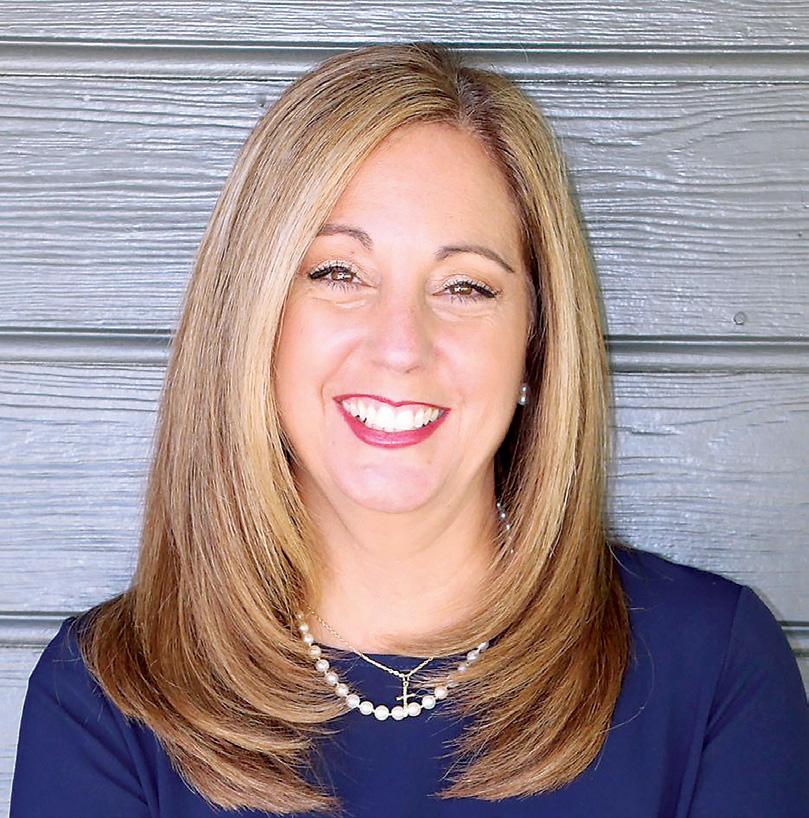
“ Is your family protected? ”
LISA M. GERACI lmgeraci@rcdoc.org
KINGSTON, Jamaica — Each year, parishioners, clergy and religious from the Diocese of Charlotte travel to the ghettos of Kingston, Jamaica, to support the Missionaries of the Poor in their ministry to “the poorest of the poor.”
The latest group of Charlotte pilgrims recently returned with memories and a new perspective on life after assisting the Missionaries of the Poor in feeding, bathing and loving the poor, the disabled and the sick.
When she saw the trip in Sacred Heart Parish’s bulletin, Melinda Osborne knew this was the time and Jamaica was the place for her first mission trip.
Along with eight other parishioners, plus Father Matthew Dimock and Deacon Maximilian Frei, she boarded the plane on June 17 – nervous and excited, but ready.
What she saw upon arrival shocked her.
“It is so much worse in Jamaica than I could have ever imagined, and it touched my soul so deeply. This truly is the poorest of the poor,” Osborne said.
Makeshift houses were pieced together with metal scraps and duct tape, and people on street corners looked hopeless and lost. Yet the love of the MOP brothers seemed to wash away the despair that drenched the Kingston streets.
The area is rough and high walls surround each residence, yet as Osborne traveled with the brothers, crowds parted like the Red Sea.
“Everybody was really nice to the brothers and respectful because they know what they do for helping the orphans, the disabled, the HIV infected, the mentally ill, the elderly and the sick,” Osborne said.
The love of the brothers matched that Osborne saw in the residents of the six “apostolates,” or centers.
then by the end of the trip, everybody’s changed and touched in different ways,” Washington said. “Everybody brings something back that they will keep with them for the rest of our lives.”
The poor conditions do not hit her as much as they did when she first visited with her son in 2006. Now, after 19 years, the place feels welcoming.
“I kind of fell in love with it, and I’ve been coming ever since. The first couple of times, I felt different when I came back, but now it’s just a part of me,” she explains.
She’s watched the residents grow up, grow old, and sometimes even die, which is difficult when over the years she has become so attached.
When she walks into a room, time stops as her friends gather around her, shouting her name and giving her bear hugs.
“The highlight of the trip is always seeing (MOP founder) Father (Richard) Ho Lung and spending time with him,” Washington said. “He is just the most holy man. I tell everybody when we leave that you have been in the presence of a saint.”
The MOP brothers are now friends. They communicate on WhatsApp, and she brings donations to the brothers in Monroe to send to her beloved Jamaica.

“They just seem so gentle and not have an ounce of frustration,” she said. She expected she’d change diapers for the deformed, run baths for those unable, and spoon-feed rice and chicken into the mouths of orphans. Yet her heart jumped at unexpected moments – the smile of a 103-year-old woman in the HIV center, her giggles as she sang and danced alongside the children, and the delight she took in painting the toenails of a long line of elderly men.
“God had given these chosen ones a golden ticket to heaven because they are so special and so unique,” Osborne said.
She spent hours washing residents’ clothing, yet when her shift was over, she wanted to stay to share one more smile with “the chosen hand-picked flowers of God.”
“I will go on this mission every year if I am able to because of the joy,” she said.
Osborne left more than just the clothes and hygiene items from her suitcase in Jamaica with the Missionaries of the Poor. She left her heart.
“You can’t go through something like this without it touching your heart. It is so powerful and overwhelming,” she said, noting the brothers “have forever changed my life.”
Sacred Heart parishioner Renee Washington loves bringing mission groups to Jamaica.
“It is amazing to watch the people that go with me on the first day of the trip, and
Her son doesn’t physically travel with her to Jamaica anymore. He died in 2007 of cancer, but she said he is the reason she keeps coming back. The memories still live there, reminding her of him.
FATHER: ‘INTENSE SPIRITUAL EXPERIENCE’
Father Dimock thinks the trip is becoming a beautiful tradition for diocesan clergy. This is his second time going, and he was thrilled to bring Deacon Frie.
“A lot of men and priests in the diocese have been on that trip and have felt the impact of that experience,” he said.
“Staying with the brothers is an intense spiritual experience. It is a beautiful experience of the human condition.”
Instead of caring for the poor, priests are tasked with ministering to the brothers, nourishing them spiritually.
“It showed a different part of my priesthood being a spiritual father to not only the small group from the parish, but being a spiritual brother’s father,” Father Dimock reflects.
He spent his time hearing confessions from the brothers and celebrating Mass, where he molded his homilies for the brothers and his parishioners.
On his last trip, a MOP brother told Father Dimock, “The chrism is still not dry on your hands from your ordination yet can still be mingled with the dirt and the feces of Jamaica” – a graphic image that continues to resonate for him.
“This trip demonstrates the desperate aspect of the service of a person, and it’s good for all our priests and seminarians to take from that perspective,” he said.
may be out for summer, but the chance to learn about faith – and have fun while doing so – got an A+ from thousands of children across the diocese who participated in parish Vacation Bible Schools, Totus Tuus and other faith-filled summer camps. Totus Tuus brings college-age missionaries to parishes to teach campers about the Catholic faith through a weeklong dive into the sacraments, prayer, skits, lessons and games. Other summer camp programs focused on sacred music at Holy Cross Parish in Kernersville (read more on page 11), service projects through St. Pius X Parish’s “Mission Mondays” in Greensboro and celebrating culture during the Vietnamese “Lua Thiêng” (“Holy Fire”) camp in High Point.



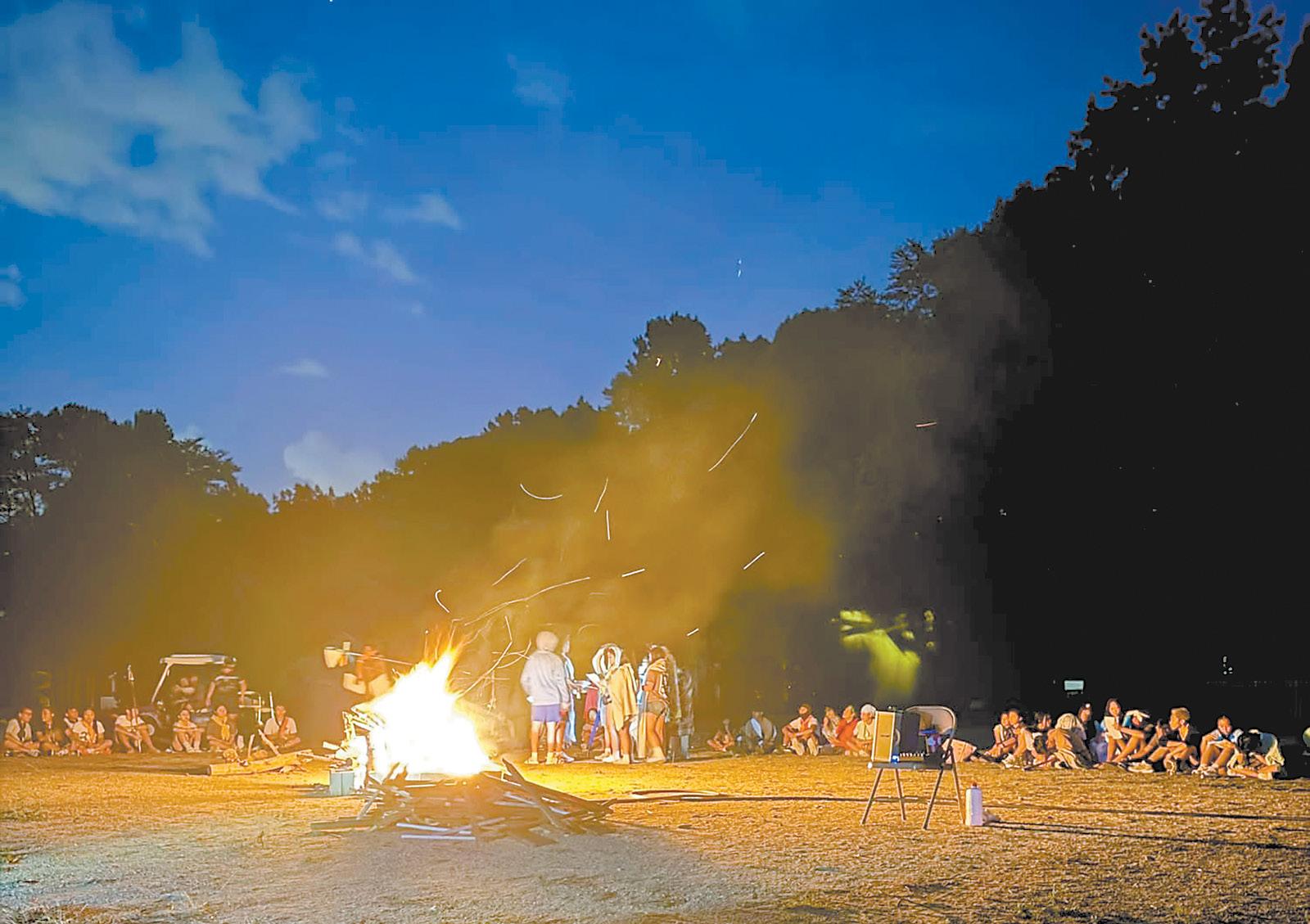

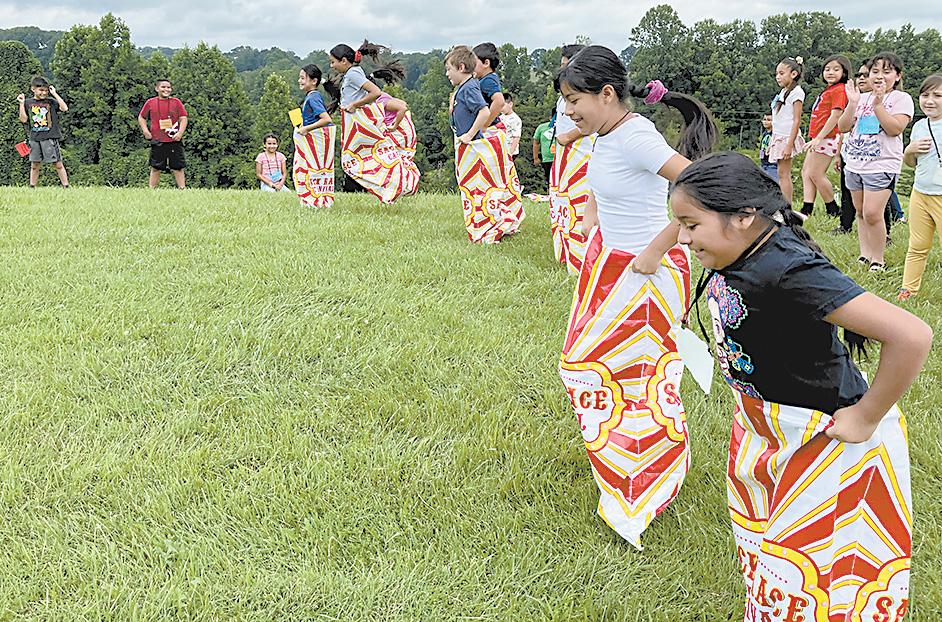

LISA M. GERACI lmgeraci@rcdoc.org
ASHEVILLE — Busker Bobby Hughes, aka Bobby Sax, has a soundtrack that’s filled the streets of downtown Asheville for the past 25 years.
Typically, he can be spotted playing his saxophone on the sidewalks of McCormick Field, Pack Square Park and all the churches in between.
Sax, now 82, is slowing down a bit, yet he never fails to fill the mountain air with notes after noon Mass on Sundays as 400 parishioners exit St. Lawrence Basilica. After the last church hymn is sung, Sax’s performance begins.
“It’s great that I am able to make them smile and be an inspiration for them,” said Sax. “I’ve been doing the basilica for at least 15 years.”
He has learned to furrow his brow, blow up his cheeks, and sway his hips while playing classics like “Over the Rainbow” and “Amazing Grace.” People call it tone, but Sax said it is about working the crowd, an audience he understands, responds to and loves.
“A good player knows how to read their audience. I play all flavors all the way from the oldies down to the babies,” said Sax. “That’s what kept me alive straight across the board all these years.”
Recently, Sax had an inspiration he thinks came from God: “The Lord has spoken to me about it. He said that I should be playing ‘Ave Maria.’ I’m learning. Especially for the people at the basilica, a lot of people asking for that one.”
LIFETIME FRIENDS
Newer parishioners at St. Lawrence may not remember Father Wilbur Thomas, the diocese’s first African American priest, who served at the basilica from 2000 to 2018 and passed away in 2022. Sax counted him as a friend. “I miss Father Thomas. He knew what I was going through. He wrote me checks sometimes so I could get by with my rent, and he even visited me when I went to the hospital,” explained Sax.
Sax calls Asheville home because of the people and their love. His supporters donated a bicycle when his was stolen and saxophones when his trailer burned to the ground.
“They ran a story about me and the fire in the local
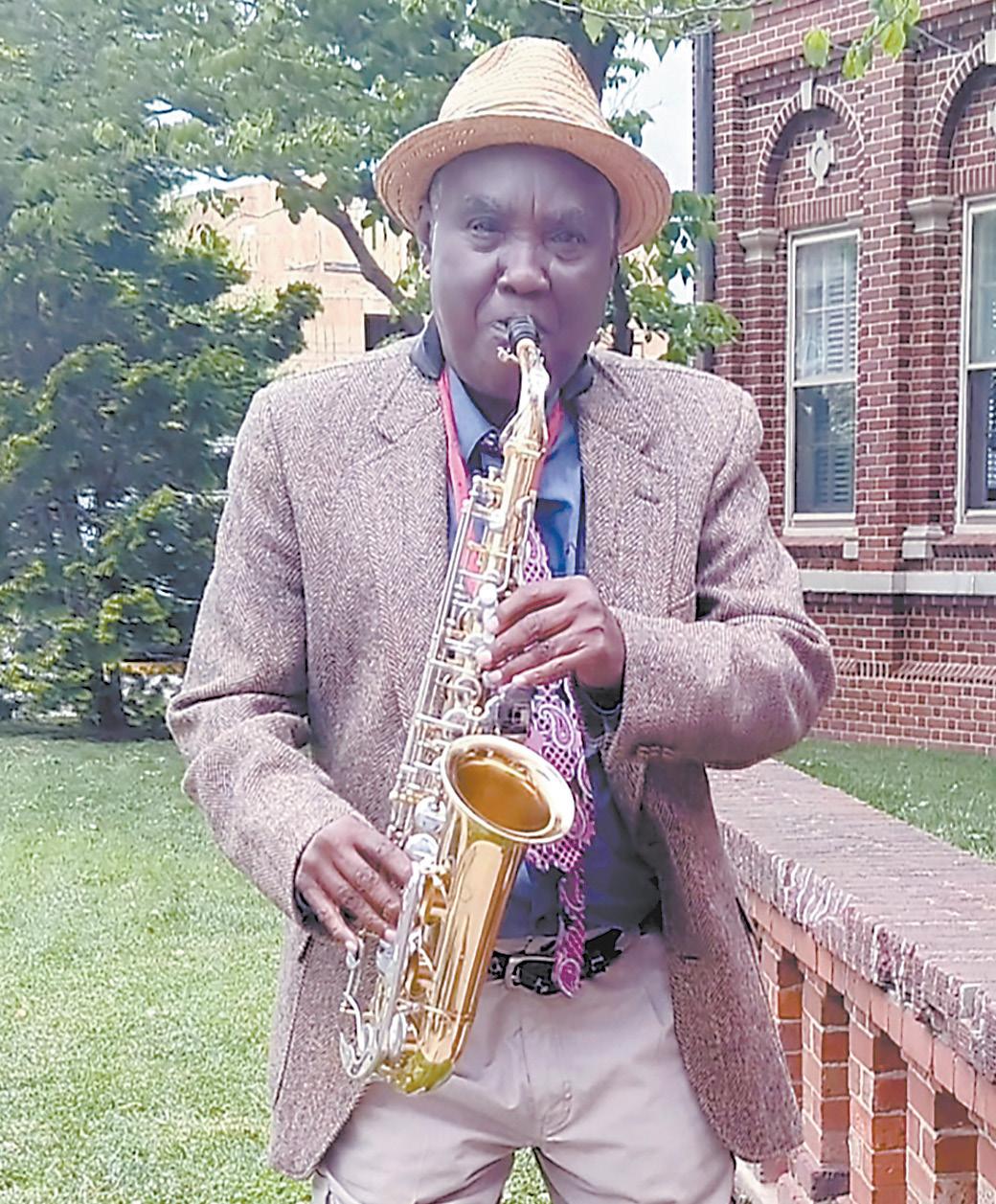
paper, and people donated saxophones to me,” said Sax. “I lost four saxophones in the fire and was given five afterward.”
For Sax, compliments are more inspiring than gifts. He’ll never forget the woman who said his rendition of “Amazing Grace” changed her day. Or when the pastor at Central United Methodist Church on Church Street invited him to come worship after the police said he couldn’t play there anymore.
He also made enduring friends, like two sisters who crossed the street to listen to him play in front of the church. They stayed an hour and kept coming back each time he was there.
“I had this relationship with those two old ladies. They used to visit me for years, and I’d play for them,” said Sax. “One of the sisters got sick and then died. The other sister went into the old person’s home. Well, I went there and took a job there because of her. I loved her.”
In his youth, he learned from the best, taking gigs at nightclubs throughout D.C. and Detroit and playing alongside Marvin Gaye.
“I played with him for four gigs in 1977 right before his daddy killed him,” said Sax.
Sax played at Carnegie Hall with The Floaters and recorded his own record. He toured military bases up and down the East Coast and played in Montego Bay, Jamaica, but nothing quite felt like home until he reached Asheville.
“An old friend asked me if I wanted to play for a while where he lived in Asheville, and I did. I am still here,” smiled Sax.
SOUTHERN ROOTS
Sax was no stranger to the South. He grew up in Monroe and returned in the 1990s to care for his mother, who had cancer. But this was a New South, much different from his childhood memories.
Growing up in Monroe back then had meant dealing with the injustices of segregation. Being a black child, his skin color played a role in where he could go and what he could do.
He watched movies by entering through back doors and standing on the balcony at Center Theatre Downtown and ordered sandwiches from Oasis through a window for black customers. Local black activists jumped into white
churchgoers at St. Lawrence Basilica and other area churches for 25 years. He reflects on decades of getting to know the parishioners and the community that he now considers home.
swimming pools as a form of protest, and Sax watched as the whites squirmed out of the water as if it were shark infested. His small heart started swelling with rage that eventually and unexpectedly led him to become a Christian. He walked down the sidewalk at age 10, spotting a white child around his age.
“I made it look like an accident, but I ran into the kid so hard, he fell to the ground. I could tell I really injured him,” Sax remembered. “I expected him to yell at me, downgrade me, insult me, just like all the others, but he looked up and was so apologetic, so full of love. I felt so awful about it, I knocked on his door later that night to make sure he was OK. That’s the day I really started believing in God. That’s why I love music. Music has no color, so there are only two kinds to me: good and bad.”
Sax was also around 10 when he heard the rhythm and blues of Joe Turner’s hit “Shake, Rattle and Roll” blaring from the local Wadesboro radio channel.
“The sax would come on in that song, and it was so good,” Sax reminisced. “I would race home every day at the same time just to hear it.”
He begged his mom for a saxophone, but she said, “Bobby, you’re not gonna do anything with a saxophone.” Sax persisted by asking his biggest fans, his grandparents, who couldn’t resist.
“We had a special bond; that’s where I saw God,” said Sax. “My grandmother was 101 when she passed, and all she did, morning, noon and night, was pray.”
When he left his childhood home, he took his music teacher’s sax and headed to Washington, D.C., where he was further schooled.
“We got off our jobs every day and practiced. But after a while, I was like, ‘We’ve practiced enough. I think it’s time for us to go ahead and perform,’” said Sax.
Sax moved on and has been filling the streets with music ever since.
Sax has plans for the future. He wants a $500 mouthpiece and a three-wheel electric bike to get around a little better. “I’ll perform as long as I can breathe. I feel good. People keep me inspired,” he said. “They have been coming to listen to me for years and will be listening to me for years to come.”

LISA M. GERACI lmgeraci@rcdoc.org
LINCOLNTON — Violin virtuoso Father Michael Carlson and parish organist Ginny Ohlault debuted a summer classical concert, serenading more than 200 attendees at St. Dorothy Parish.
Despite competing summer activities, the parking lot quickly filled with people from Lincolnton, Linville, Huntersville and Charlotte.
Parish office manager Alison Speed was delighted that folks outside the congregation attended.
“Lincolnton hadn’t had a classical musical concert for quite a long time,” said Speed. “It was so nice, beautiful and refreshing to have this concert here.”
Father Carlson added, “Even students from Davidson, where I said Mass a few times, made the trip out. The St. Mark parishioners and all the ones from St. Dorothy, and of course, my sister, brother and mother.”
Parishioners were surprised and inspired watching Father Carlson masterfully bow classics such as “Clair de Lune” by Claude Debussy.
“With music, sometimes you can express things that are more difficult or impossible to express with words,” noted Father Carlson. “It is an incredibly fulfilling endeavor to reach people in a certain way you can’t with the spoken word. It can be quite a mystery. A beautiful thing that God has given us.”
As Father Carlson focused on his role as pastor, his violin case gathered dust. Now, he’s brushed it off, and the parish is taking notice.
“Most everyone was rather impressed and happy to be able to share that music with me and Ginny. It was truly a fulfilling afternoon,” said Father Carlson.
The idea of a concert started when the women’s group heard Father Carlson’s renditions of works by Sergei Prokofiev and Antonio Vivaldi. Not able to keep such a treasure to themselves, they asked if he’d consider collaborating with Ohlhaut.
“We had a lot of fun with the concert program and came up with a mix of things. Some were songs that I’ve had on my mind that I really wanted to play in front of an audience.
Like the Prokofiev,” said Father Carlson. “Vivaldi, being a priest himself, we thought it was only appropriate to include him.”
To prepare for the performance, Father Carlson picked up the prized violin he’s had since high school and started rehearsing for up to an hour a day.
He is no stranger to strict training. At one point he drilled himself for six hours a day, repeating works until the artists and the player became a blurred line.
“Any instrument takes a bit of time to start to understand, especially the violin. The movements demanded, especially in the arms, are not particularly natural,” reflected Father Carlson. “Yet, I was so struck by the beauty and the sound quality that difficulty didn’t matter to me. I was going to take whatever practice time there was needed to master the instrument.”
For Christina Broodno, a parishioner at St. Gabriel in Charlotte, hearing her brother brought back childhood memories of evenings she and her siblings listened to and played the classics.
“He has been playing since he was seven. There are six of us; the three youngest play. They played together for our wedding,” said Broodno. “I’ve heard him play those pieces dozens and dozens of times. It’s a cherished hobby for him, and a way for him to give glory to God. A way to escape in himself and relax. He finds some solace in it, and for him it’s great outreach as well.”
During high school, he performed with orchestras sprinkled throughout Central Valley, California, where he grew up. He went on to the University of Montana to study violin, hoping to perform professionally. Those plans were put on hold after he developed tendinitis, leaving him unable to practice. God used the setback to make His plans clear, as Carlson left college and discerned his calling to the priesthood.
Ohlhaut and Father Carlson are excited about the future of their musical duo.
“We are starting to kick around ideas, possibly a Christmas concert, but if that doesn’t materialize, we plan to play again next summer. Parishioners have mentioned some kind of recording, and we are open to that,” he said.
LISA M. GERACI lmgeraci@rcdoc.org
KERNERSVILLE — Campers hit a high note at their first Vespers performance after a week of chanting, learning and fun at Holy Cross Parish’s summer sacred music camp.
“It is really humbling to see kids being able to offer their gifts to Our Lord through their voices,” said Oscar Hernandez, the church’s sacred music director and camp organizer.
More than 40 children from Holy Cross and neighboring parishes St. Paul the Apostle, St. Leo the Great, Our Lady of Mercy, Our Lady of the Highways and Our Lady of Grace learned liturgical hymns sung during Mass. The camp focused on Latin pronunciation, music theory, church teachings on sacred music and polyphony (combining two or more tones).
Each night campers gathered around the piano to practice newly mastered Gregorian chants and sing the Divine Mercy Chaplet. Friday’s finale showcased their talents to an audience of parents and parishioners.
“Our pastor, Father Noah Carter, really goes out of his way to let us know that sacred music is really something that is needed in the Church,” said Hernandez.
“He is a very big supporter of our program.”
Hernandez was adamant cost should not be a barrier, so the camp was offered free of charge. Thanks to volunteers and donors, the campers stayed happy, educated and full.
“The Columbiettes, the Knights of Columbus, our office of faith education, and our Spanish Charismatic prayer group were super kind by providing us with dinner,” said Hernandez.
Hernandez said the camp offered an opportunity for young singers to grow in confidence.
When Hernandez started at the parish six years ago, there wasn’t a sacred music program. He is hopeful that many of these young prodigies will use the experience as a stepping stone to join their own church choirs.
“Here at the parish, we try to really focus on sacred music. A lot of polyphony is what we try to do at the Holy Sacrifice of the

Mass; however, it’s hard to do that because it takes a certain number of singers,” said Hernandez, who has played the piano since he was 6.
Hernandez believes singing in Latin helps eliminate language barriers during Mass. Each camper received a book full of
More than 40 children from Holy Cross and neighboring parishes attended the first Sacred Music Camp at Holy Cross Parish. The camp helped eliminate language barriers and brought the entire congregation together to hear their children perform.
Latin chants, with both English and Spanish translations.
“I wanted something both the Anglo and Hispanic communities could learn, so when we come together for Masses, it is something we can do together. So, we have something that joins us,” said Hernandez.
The Santos de Palo Tradition
WHAT: Exhibit of more than 150 carved wooden sculptures of saints, holy figures and sacred scenes produced by artists in Puerto Rico.
WHEN: Opens Aug. 2 and runs through July 5, 2026
WHERE: Mint Museum Randolph, 2730 Randolph Road, Charlotte
HOURS: 11 a.m.- 6 p.m. Tuesday, Thursday Friday, Saturday; 1 to 5 p.m. Sunday; 11 a.m. to 9 p.m. Wednesday. Closed Monday.
HOW MUCH: Free for members, children 4 and younger, students in grades K-12 and college art students.
$15 for adults, $10 for seniors ages 65 and older, $10 for college students with ID. Free 5-9 p.m. Wednesdays.
CONTACT: (704) 337-2037 www.mintmuseum.org
The blessed mother is a frequently depicted subject in santos de palo carvings.

Towalk into the Charlotte home of Francisco Toste
Santana and wife Nitza
Mediavilla Piñero is to enter a living space infused with sacred beauty.
Rooms throughout the house are filled with hundreds of expertly carved wooden figures representing Jesus, the Blessed Mother, the Three Kings and many beloved saints.
These are small traditional wooden sculptures called “santos de palo” (“wooden saints”) that the couple lovingly collected and brought with them when they moved to Charlotte from their native Puerto Rico five years ago.
They embrace the figures as representations of their Catholic faith and cultural heritage, and decided to share them with the public through a special exhibition opening Aug. 2 at Mint Museum Randolph.
“Art of Devotion: The Santos de Palo Tradition of Puerto Rico” will run through July 5, 2026, and feature more than 150 examples of this artistic tradition that started with grassroots artists in the 1750s and endures as an important expression of Puerto Rican art and faith today.
“We never intended to start a collection – we just gathered these over the years because we loved them,” says Francisco Toste, a retired businessman who goes by “Paco.” “They are an expression of our Puerto Rican heritage and faith, and we decided we wanted to share the tradition with others.”
ART BEGAN AT HOME
The Mint Museum jumped at the chance to showcase the religious and cultural tradition of carving santos figures, which began in the generations after Puerto Rico was first settled by the Spanish in the 16th century.
“As the Mint deepens its commitment to celebrating the art, traditions and voices of our growing Latin community, the Tostes’ collection presented an extraordinary storytelling opportunity,” says Chief Curator Jen Sudul Edwards, “not only for Latin and Catholic audiences, but for our entire region. We felt that the santos de palo tradition spoke to the spiritual


power held in art, and to the profound meaning a single object can carry for both an artist and a community.”
The museum turned to Durham-based Dorie Reents-Budet to curate the santos exhibition because of her background in the history of the ancient Americas. She has a doctorate in art history and is familiar with the santos tradition in part because her husband is of Puerto Rican descent.
“The santos de palo tradition embodies not only spiritual faith but also the cultural pride of contemporary Puerto Rico,” she says, “intermingling its Catholic heritage with contemporary topics while reflecting its Hispanic, indigenous Taino and Carib and African legacy.”

Until the 20th century, she says, many people in Puerto Rico lived in rural areas often surrounded by dense forests, without regular access to priests and churches. To preserve their faith, people created home altars featuring carved figures representing Christ, Mary and saints to focus their devotions. These early figures were carved from native woods, most often cedar, with tree branches and roots also used to form the sculptures.
Early santos were done in a Spanish baroque style because many of the carvers, called “santeros” (“saint makers”) copied images from prayer cards distributed by traveling priests who crisscrossed the island from the 16th through the 18th centuries. Beginning in the late 18th century, santeros introduced
Puerto Rico is an island in the Caribbean and an unincorporated U.S. territory. Its capital is San Juan.
POPULATION: 3.2 million people live on the island. An estimated 5.9 million Puerto Ricans live in the mainland U.S.
IN NORTH CAROLINA: The Puerto Rican population of North Carolina was 132,824 as of 2023 (Source, U.S. Census Bureau Community Survey). Mecklenburg, Wake and Cumberland counties have the largest Puerto Rican populations.

HISTORY: Claimed by Spain after Christopher Columbus arrived in 1493 and first colonized by Ponce de Leon in 1508. It became a U.S. territory in 1898.

their own styles and interpretations. The tradition lives on with modern artists incorporating Puerto Rican symbols and other elements.
Francisco and Nitza’s collection includes santos dating from the 18th century up to contemporary times. While the exhibition features just a fraction of their collection, a
The couple started collecting 51 years ago in 1974, all because Francisco went in search of a perfect anniversary gift for his wife.
“We were celebrating our fifth anniversary, and the traditional gift for that year is wood,” he says.” I decided to go to Old San Juan and visit art galleries to see what was available. In one, I saw a display of 20 old santos and decided on the Three Kings.”
The artwork cost $125 – a lot for the couple’s monthly income at the time – and Nitza fell in love with the figure’s bright colors and detail. So, for their next anniversary, Francisco purchased another santo depicting the Holy Trinity.

Over the ensuing years, they visited town art fairs around Puerto Rico and bought santos by contemporary artists.
In 1993, an exhibition of a collection of early santos owned by New York-based collector Alan Moss came to an art museum in Ponce, Puerto Rico, and the couple became fascinated by the older style. They wanted to purchase some but couldn’t find any available because most were already in private collections, Francisco says. Instead, they started visiting contemporary santeros at their home studios to purchase newer works. They acquired more and more.
Eventually they visited Alan Moss in New York and bought some of his older pieces. Moss decided he wanted to sell most of his santos because he believed the works should return to Puerto Rico, so Francisco agreed to represent him there.
“Over 25 years, we sold hundreds of his santos to old and new collectors in Puerto Rico and at the same time acquired ours,” Francisco says.
KEEPERS OF THE CUSTOM
The wooden figures that fill their home especially appealed to Nitza, who has a background in art and architecture, and she has lovingly arranged the santos on display in a harmony of style and color. Sacred figures line shelves and tables in nearly every room.
They also have dozens of versions of the


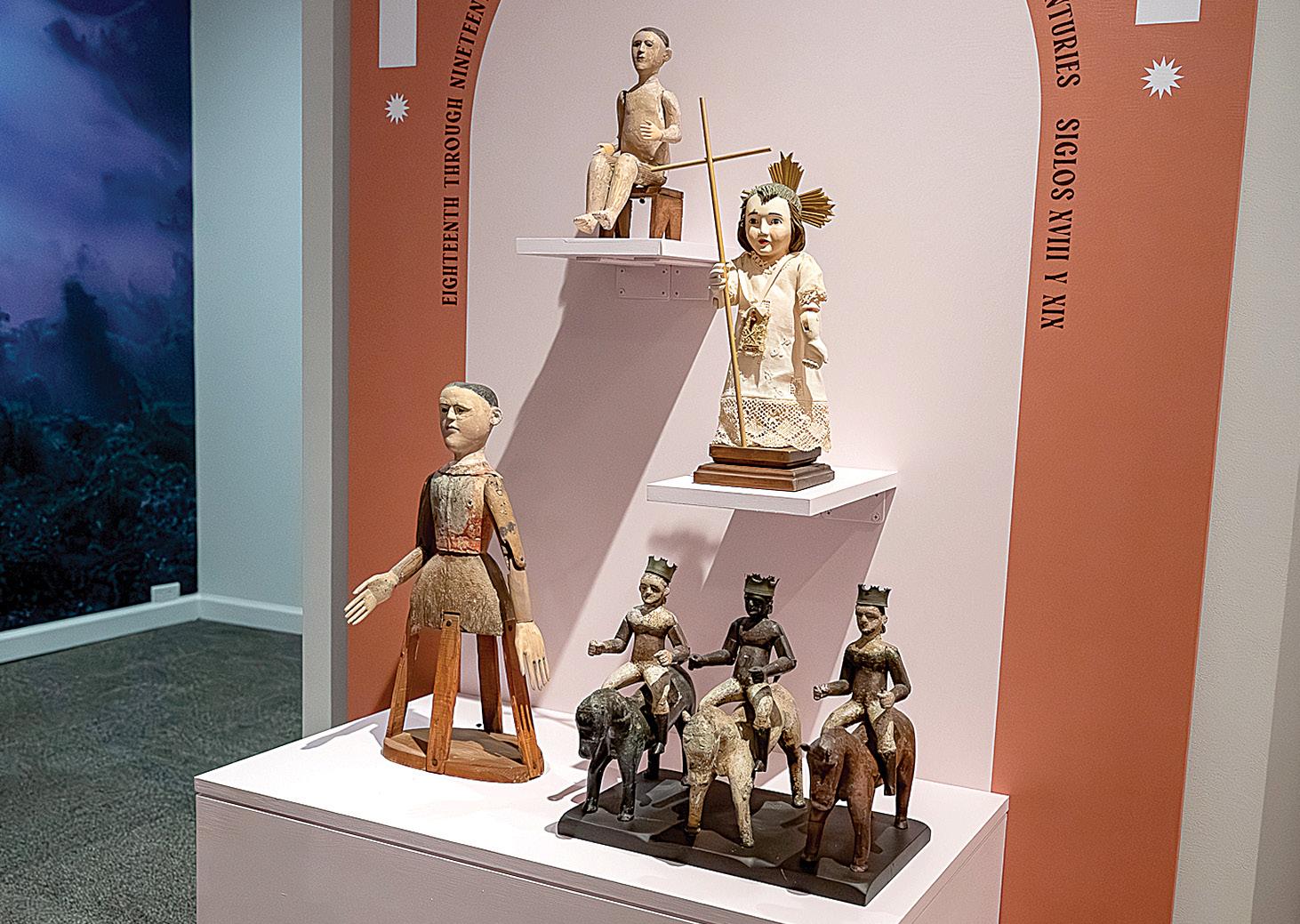
from
and faith, and we decided we wanted to share the tradition with others,”
Magi, or the Three Kings, displayed. This is one of the most common devotions in Puerto Rico, evident in the island’s vibrant annual celebration of Epiphany, or Three Kings Day, on Jan. 6.
They both have written books on the art form – Francisco has penned two, while Nitza has written five.
She translated her interest in the santos into real life artistry by taking a course in woodworking and then carving her own.
Several of her artistic carvings are on prominent display in their home, and one or two are included in the exhibition. Several


have special meaning, including a figure of St. Raymond de Nonnatus, patron saint of pregnancy, that she carved while one of her daughters was expecting her first child.
Nitza says it’s hard for her to pick out a favorite santo because she loves all of the stories and devotions behind them.
“I found that after we put the collection together to go to the Mint, I was looking around and really missed having certain ones here,” she says.
Both Nitza and Francisco love having the santos in their home and treasure the chance to share this beloved art form with others.
Francisco says: “We believe we are the temporary custodians of this representation of the Puerto Rican tradition, culture, art and the Catholic faith.”


Until the 20th century, many people in Puerto Rico lived in rural areas and lacked access to priests and churches. To preserve their faith, people created home altars featuring carved figures representing Christ, Mary and saints to focus their devotions. These beautiful pieces of sacred art are as diverse as the sculptors who have created them over the centuries.
Nitza Mediavilla Piñero has taken her love for santos de palo – the traditional Puerto Rican wooden devotional sculptures she and her husband collect – to another level. She took a class in woodcarving and used what she learned to become a santero (those who make the sculptures).
Over the years she has created her own santos de palo, carving figures of Christ, the Blessed Mother and saints and then adding vivid colors with oil paints. Her work is unique because she carves each figure from a single
block of cedar wood. Some have taken her more than a year to complete.
“When I first started carving, I was still working in a family business so I would get a chance to work an hour here, an hour there,” she said. “I always take my time. This is a devotion for me. It’s a skill God has given me.”
One of the most special santos de palo she has made is the figure of St. Raymond Nonnatus, the patron saint of pregnancy and childbirth. She made it for one of her daughters when she was expecting her first child.

‘A ARTE DE LA DEVOCIÓN’
CHRISTINA LEE KNAUSS clknauss@rcdoc.org
CHARLOTTE — Entrar a la casa de Francisco Toste Santana y su esposa Nitza Mediavilla Piñero en Charlotte es sumergirse en un espacio lleno de belleza sagrada.
Las habitaciones están llenas de cientos de figuras de madera finamente talladas que representan a Jesús, la Virgen María, los Reyes Magos y muchos santos queridos. Estas pequeñas esculturas tradicionales de madera se llaman santos de palo, que la pareja ha recopilado con amor y trajo consigo al mudarse desde su natal Puerto Rico a Charlotte hace cinco años.
Ellos abrazan estas figuras como representaciones de su fe católica y su herencia cultural, y decidieron compartirlas con el público a través de una exposición especial que se inaugura el 2 de agosto en el Museo Mint Randolph.
“El Arte de la Devoción: La Tradición del Santo de Palo en Puerto Rico” estará en exhibición hasta el 5 de julio de 2026 y contará con más de 150 ejemplos de esta tradición artística que comenzó con artistas populares en el siglo XIV que aún perdura como una importante expresión del arte y la fe puertorriqueños.
“Nunca tuvimos la intención de comenzar una colección – simplemente los fuimos adquiriendo a lo largo de los años porque los amábamos”, dice Francisco Toste, un empresario retirado que se hace llamar “Paco”. “Son una expresión de nuestra herencia puertorriqueña y fe, y decidimos que queríamos compartir esta tradición con los demás”.
online
En catholicnewsherald.com/espanol : Conozca más sobre la exhibición y vea más fotos.
EL ARTE COMENZÓ EN CASA
El Museo Mint no dudó en aprovechar la oportunidad de mostrar esta tradición religiosa y cultural de tallar figuras de santos, que comenzó en las generaciones posteriores a la llegada de los españoles a Puerto Rico en el siglo XVIII. “A medida que el Mint profundiza su compromiso de celebrar el arte, las tradiciones y las voces de nuestra creciente comunidad latina, la colección de los Toste representó una extraordinaria oportunidad para contar una historia”, dice la curadora principal Jen Sudul Edwards. “No solo para audiencias latinas y católicas, sino para toda nuestra región. Sentimos que la tradición del santo de palo hablaba del poder espiritual contenido en el arte y del profundo significado que un solo objeto puede tener tanto para el artista como para la comunidad”. El museo recurrió a Dorie Reents-Budet, con sede en Durham, para curar la exposición, debido a su experiencia en la historia de las Américas antiguas. Tiene un doctorado en historia del arte y está familiarizada con la tradición de los santos en parte porque su esposo es de ascendencia puertorriqueña.
“La tradición del santo de palo encarna no solo la fe espiritual, sino también el orgullo cultural del Puerto Rico contemporáneo”, dice ella, “mezclando su herencia católica con temas contemporáneos, mientras refleja el legado hispano, indígena taíno y caribe, y africano”. Hasta el siglo XX, muchas personas en Puerto Rico vivían en zonas rurales, a menudo rodeadas de bosques densos, sin acceso regular a sacerdotes ni iglesias. Para preservar su fe, las personas creaban altares domésticos con figuras talladas que representaban a Cristo, la Virgen y a los santos, para enfocar su devoción. Estas figuras eran talladas en maderas nativas, principalmente en cedro, y también se usaban ramas y raíces.
Los primeros santos se hacían en estilo barroco español, ya que muchos de los talladores, llamados santeros (“hacedores de santos”), copiaban imágenes de estampitas distribuidas por sacerdotes itinerantes que recorrían la isla entre los siglos XVI y XVIII. A partir de finales del siglo XVIII, los santeros comenzaron a desarrollar sus propios estilos e interpretaciones. La tradición continúa


viva hoy con artistas modernos que incorporan símbolos puertorriqueños y otros elementos.
La colección de Francisco y Nitza incluye santos que datan desde el siglo XVIII hasta obras contemporáneas. Aunque la exhibición muestra solo una fracción de su colección, incluye una gama completa de estilos.
UNA COLECCIÓN NACIDA DEL AMOR
La pareja comenzó su colección hace 51 años, en 1974, todo porque Francisco buscaba el regalo perfecto de aniversario para su esposa.
“Celebrábamos nuestro quinto aniversario, y el regalo tradicional para ese año es la madera”, dice. “Decidí ir al Viejo San Juan y visitar galerías de arte para ver qué encontraba. En una, vi una exhibición de 20 santos antiguos y me decidí por los Reyes Magos”.
La obra costó $125 – mucho para el ingreso mensual de la pareja en ese momento – y Nitza se enamoró de los colores vivos y los detalles de la figura. Así que, para su siguiente aniversario, Francisco compró otro santo que representaba la Santísima Trinidad.
En los años siguientes, visitaron ferias de arte por todo Puerto Rico y compraron santos de artistas contemporáneos.
En 1993, una exposición de santos antiguos del coleccionista neoyorquino Alan Moss llegó a un museo en Ponce, Puerto Rico, y la pareja quedó fascinada por el estilo antiguo. Querían comprar algunos, pero no
Francisco Toste Santana y su esposa Nitza Mediavilla Piñero han estado coleccionando santos de palo durante más de 20 años. Su colección será presentada en una exhibición del Museo Mint que se inaugura el 2 de agosto.

encontraban disponibles porque la mayoría ya estaban en colecciones privadas. En cambio, comenzaron a visitar a santeros contemporáneos en sus estudios para adquirir obras nuevas. Poco a poco, fueron adquiriendo más y más. Eventualmente visitaron a Alan Moss en Nueva York y le compraron algunas de sus piezas antiguas. Moss decidió vender la mayoría de sus santos porque creía que las obras debían regresar a Puerto Rico, así que Francisco aceptó representarlo allá.
“Durante 25 años, vendimos cientos de sus santos a coleccionistas antiguos y nuevos en Puerto Rico, y al mismo tiempo fuimos adquiriendo los nuestros”, dice Francisco.
Las figuras de madera que llenan su hogar atrajeron especialmente a Nitza, quien tiene formación en arte y arquitectura, y ha dispuesto los santos con amor, armonizando estilos y colores. Las figuras sagradas llenan estanterías y mesas en casi todas las habitaciones.
También tienen decenas de versiones de los Reyes Magos. Esta es una de las devociones más comunes en Puerto Rico, evidente en la vibrante celebración anual del Día de Reyes, el 6 de enero.
Ambos han escrito libros sobre esta forma de arte –Francisco ha escrito dos, y Nitza cinco.
Nitza llevó su interés por los santos a la práctica artística al tomar un curso de carpintería, donde aprendió a tallar sus propias figuras.
Varias de sus tallas están en exhibición en su hogar, y una o dos forman parte de la exposición. Algunas tienen un significado especial, como una figura de San Ramón Nonato, patrono de los embarazos, que talló mientras una de sus hijas esperaba a su primer hijo.
Nitza dice que le resulta difícil elegir un santo favorito porque ama todas las historias y devociones que representan.
“Después de que preparamos la colección para llevarla al Mint, me di cuenta de que al mirar alrededor, realmente extrañaba tener algunos aquí”, dice.
Tanto Nitza como Francisco aman tener los santos en su hogar y atesoran la oportunidad de compartir esta querida forma de arte con otros.
Francisco dice: “Creemos que somos custodios temporales de esta representación de la tradición, cultura, arte y fe católica puertorriqueña”.


CÉSAR HURTADO catholicnews@rcdoc.org
CHARLOTTE — En el año 2000, mientras servía en una parroquia de Carolina del Sur, el Padre José Antonio Juya Vargas recibió una invitación del Padre Vicente Finnerty, entonces director del ministerio hispano de la Diócesis de Charlotte, para integrarse a esta floreciente labor pastoral. “Te daré la vicaría más fácil, la de Gastonia”, le aseguró al sacerdote, que en aquel entonces tenía 48 años.
“Y no fue nada fácil”, recuerda hoy el Padre Juya al evocar los inicios del ministerio hispano en la diócesis. Los recursos eran escasos y, día a día, aumentaba la demanda de atención a medida que la población latina crecía. Sin embargo, esas dificultades no lo detuvieron; al contrario, se convirtieron en un estímulo que fortaleció su misión.
El pasado 8 de julio, después de 25 años sirviendo como coordinador del ministerio hispano de la Vicaría de Gastonia, el Padre Juya se retiró oficialmente. “Quiero volver a viajar y visitar lugares que, por el trabajo, no pude recorrer de nuevo, especialmente en Europa”, compartió. En las parroquias de Forest City, Gastonia, Lincolnton, Shelby y Belmont —todas ellas acompañadas por él en su labor pastoral— se sucedieron emotivas despedidas. “Gracias a Dios, hoy nuestros hermanos hispanos cuentan con atención espiritual, se celebra la Misa, se administran los Sacramentos. Hemos crecido en formación, en número de fieles, en integración, en compromiso, en ministerios y en liderazgo”, expresó con satisfacción.

COLOMBIANO BOYACENSE
Nacido en Rondón, Boyacá (Colombia), en julio de 1952, recibió una sólida formación católica gracias al ejemplo de su madre, activa líder de las Hijas de María y de la Legión de María. A los 13 años, al finalizar la primaria, sus padres enviaron a José y a su hermano Filemón a Bogotá para estudiar en el seminario de los hermanos misioneros Somascos. Tras varios años de preparación, el 12 de diciembre de 1981 —fiesta de Nuestra Señora de Guadalupe— ambos fueron ordenados sacerdotes en la iglesia San Rafael, en su natal Rondón. Juntos iniciaron su labor misionera en Canadá, Europa, Centroamérica y, finalmente, en Carolina del Sur.

El pasado 8 de julio, después de 25 años sirviendo como coordinador del ministerio
el
En 2011, el Padre Filemón Juya falleció mientras servía en dos parroquias de Batesburg-Leesville, Carolina del Sur. Esta pérdida marcó profundamente al Padre José Juya, quien logró sobreponerse gracias al apoyo y acompañamiento de sus feligreses, continuando así su misión pastoral.

PASIÓN MISIONERA
oficialmente. En
A pesar de su retiro, el Padre Juya planea seguir colaborando, en la medida de sus posibilidades, con las cinco parroquias de la vicaría donde inició los servicios en español y que ayudó a fortalecer y expandir. “Amo mi vocación sacerdotal y me siento muy feliz de ver los frutos obtenidos gracias al compromiso de tantos líderes que han acompañado esta historia misionera”, afirmó. Lo vamos a extrañar, Padre Juya: sus palabras de aliento, sus correcciones, sus consejos, su humor y su constante acompañamiento. Su presencia ha dejado una huella profunda en cada uno de los feligreses que tuvieron la dicha de encontrarse con usted. Seguiremos viéndonos, si Dios nos concede vida. Muchas, muchísimas gracias.

El Padre John Allen, el nuevo párroco de Saint Margaret Mary en Swannanoa, ha estado ocupado conociendo y entablando relación con su nueva feligresía. Está entusiasmado de ser el pastor de esta comunidad que ha pasado por tanto sufrimiento durante el último año. Espera con ilusión conocer a todas las familias de la parroquia.
San Ramón nació de familia noble en Portell, cerca de Barcelona, España en el año 1200. Recibió el sobrenombre de non natus (no nacido), porque su madre murió en el parto antes de que el niño viese la luz. Con el permiso de su padre, el santo ingresó en la orden de los Mercedarios, que acababa de fundarse. San Pedro Nolasco, el fundador, recibió la profesión de Ramón en Barcelona. Progresó tan rápidamente en virtud que, dos o tres años después de profesar, sucedió a San Pedro Nolasco en el cargo de “redentor o rescatador de cautivos”. Enviado al norte de África con una suma considerable de dinero, Ramón rescató en Argel a numerosos esclavos. Cuando se le acabó el dinero, se ofreció como rehén por la libertad de ciertos prisioneros cuya situación era desesperada y cuya fe se hallaba en grave peligro. Pero el sacrificio de San Ramón no hizo más que exasperar a los infieles, quienes le trataron con terrible crueldad. Sin embargo, el magistrado principal, temiendo que si el santo moría no se pudiese obtener la suma estipulada por la libertad de los prisioneros a los que representaba, dio orden de que se le tratase más humanamente. Con ello, el santo pudo salir a la calle, lo que aprovechó para confortar y alentar a los cristianos y hasta llegó a convertir y bautizar a algunos mahometanos. Al saberlo, el gobernador le condenó a morir empalado, pero quienes estaban interesados en cobrar la suma del rescate consiguieron que se le conmutase la pena de muerte por la de flagelación. San Ramón no perdió por ello el valor, sino que prosiguió la tarea de auxiliar a cuantos se hallaban en peligro, sin dejar escapar la menor ocasión de ayudarlos. San Ramón encaró dos grandes dificultades. Ya no tenía ni un solo centavo para rescatar cautivos, y predicar el cristianismo a los musulmanes equivalía a la pena de muerte. Pero nada lo detuvo ante el llamado del Señor. Consciente del martirio inminente, volvió a instruir y exhortar tanto a los cristianos como a los infieles. El gobernador, enfurecido ante tal audacia, ordenó que se azotase al santo en todas las esquinas de la ciudad y que se le perforasen los labios con un hierro candente. Mandó ponerle en la boca un candado, cuya llave guardaba él mismo y sólo la daba al carcelero a la hora de las comidas. En esa angustiosa situación pasó San Ramón ocho meses, hasta que San Pedro Nolasco pudo finalmente enviar algunos miembros de su orden a rescatarle. San Ramón hubiese querido quedarse para asistir a los esclavos
Lecturas Diarias
3–9 DE AGOSTO
Domingo: Ecl 1,2, 2,21-23, Sal 89,3-4.56.12-13.14 y 17, Col 3,1-5.9-11, Lc 12,13-21; Lunes (Memoria de San Juan María Vianney, presbítero): Núm 11,4b-15, Sal 80,12-13.1415.16-17, Mt 14,13-21; Martes: Núm 12,1-13, Sal 50,3-4.5-6ab.6cd-7.12-13, Mt 14,22-36; Miércoles (Fiesta de la Transfiguración del Señor): Dan 7,9-10.13-14, Sal 96,1-2.5-6.9, 2 Pe 1,16-19, Lc 9,28b-36; Jueves: Núm 20,1-13, Sal 94,1-2.6-7.8-9, Mt 16,13-23; Viernes (Memoria de Santo Domingo, presbítero): Deut 4,3240, Sal 76,12-13.14-15.16 y 21, Mt 16,24-28; Sábado: Deut 6,4-13, Sal 17,2-3a.3bc-4.47 y 51, Mt 17,14-20
en Africa, sin embargo, obedeció la orden de su superior y pidió a Dios que aceptase sus lágrimas, ya que no le había considerado digno de derramar su sangre por las almas de sus prójimos.
A su vuelta a España, en 1239, fue nombrado cardenal por Gregorio IX, pero permaneció tan indiferente a ese honor que no había buscado, que no cambió ni sus vestidos, ni su pobre celda del convento de Barcelona, ni su manera de vivir. El Papa le llamó más tarde a Roma. San Ramón obedeció, pero emprendió el viaje como el religioso más humilde. Dios dispuso que sólo llegase hasta Cardona, a unos diez kilómetros de Barcelona, donde le sorprendió una violenta fiebre que le llevó a la tumba. El santo tenía aproximadamente treinta y seis años cuando murió el 31 de agosto de 1240. Cardona pronto se transformó en meta de peregrinaciones. Fue sepultado en la capilla de San Nicolás de Portell.
El Papa Alejandro VII lo incluyó en el Martirologio Romano en 1657.
San Ramón Nonato es el patrono de las parturientas y las parteras debido a las circunstancias de su nacimiento.
La comisión nombrada por el Papa Benedicto XIV propuso suprimir del calendario general la fiesta de San Ramón por la dificultad de encontrar documentos fidedignos sobre su vida.
— ACI Prensa
Oración a San Ramón Nonato para un feliz parto
Oh excelso patrono, San Ramón, modelo de caridad para con los pobres y necesitados, aquí me tenéis postrado humildemente ante vuestros pies para implorar vuestro auxilio en mis necesidades. Así como era vuestra mayor dicha ayudar a los pobres y necesitados en la tierra, socorredme, os suplico, oh glorioso San Ramón, en esta mi aflicción. A vos, oh glorioso protector acudo para que bendigáis al hijo que llevo en mi seno. Protegedme a mí y al hijo de mis entrañas ahora y durante el parto que se aproxima. Os prometo educarlo según las leyes y mandamientos de Dios. Escuchad mis oraciones, amante protector mío, San Ramón, y hacedme madre feliz de este hijo que espero dar a luz por medio de vuestra poderosa intercesión.
Así sea.

Escultora puertorriqueña Nitza Mediavilla Piñero de Charlotte sostiene su talla de San Ramon Nonato en el estilo típico de Santos de Palo.
TROY C. HULL Y IMÁGEN DE ARCHIVO |CATHOLIC NEWS HERALD

10–16 DE AGOSTO
Domingo: Sab 18,6-9, Sal 32,1.12.18-19.2022, Heb 11,1-2.8-19 o Heb 11,1-2.8-12, Lc 12,32-48 o Lc 12,35-40; Lunes (Memoria de Santa Clara, virgen): Deut 10,12-22, Sal 147,12-13.14-15.19-20, Mt 17,22-27; Martes: Deut 31,1-8, Deut 32,3-4ab.7.8.9 y 12, Mt 18,15.10.12-14; Miércoles: Deut 34,1-12, Sal 66,13a.5 y 8.16-17, Mt 18,15-20; Jueves (Memoria de San Maximiliano Kolbe, presbítero y mártir): Jos 3,7-10a.11.13-17, Sal 113,1-2.3-4.56, Mt 18,21–19,1; Viernes (Solemnidad de la Asunción de la Santísima Virgen María): Ap 11,19a, 12,1-6a.10ab, Sal 44,10.11.12.16, 1 Cor 15,20-27, Lc 1,39-56; Sábado: Jos 24,14-29, Sal 16,1-2a.5.7-8.11, Mt 19,13-15
17–23 DE AGOSTO
Domingo: Jer 38,4-6.8-10, Sal 39,2.3.4.18, Heb 12,1-4, Lc 12,49-53; Lunes: Jue 2,11-19, Sal 105,34-35.36-37.39-40.43ab y 44, Mt 19,16-22; Martes: Jue 6,11-24a, Sal 84,9.1112.13-14, Mt 19,23-30; Miércoles (Memoria de San Bernardo, abad y doctor de la Iglesia): Jue 9,6-15, Sal 20,2-3.4-5.6-7, Mt 20,1-16; Jueves (Memoria de San Pío X, papa): Jue 11,29-39a, Sal 39,5.7-8a.8b-9.10, Mt 22,1-14; Viernes (Memoria de Santa María Reina): Rut 1,1.3-6.14b-16.22, Sal 145,5-6ab.6c-7.89a.9bc-10, Mt 22,34-40; Sábado: Rut 2,1-3.811, 4,13-17, Sal 127,1b-2.3.4.5, Mt 23,1-12

NOTA DEL EDITOR
Siguiendo la práctica de anteriores Santos Padres, el Papa León XIV se tomará un descanso durante el mes de julio. Sus audiencias generales semanales —que proporcionan el contenido para su columna en esta página— se reanudarán en agosto. Su columna regresará después de esa fecha.
Viernes y sábado, 5 y 6 de septiembre | Charlotte Convention Center | GRATIS


Únete a miles de fieles en una experiencia espiritual inolvidable que renovará tu fe, llenará tu corazón y fortalecerá tu esperanza.


12:30–2:30 P.M. SÁBADO, 6 DE SEPTIEMBRE
Paula Umaña Ven a escuchar el conmovedor testimonio de Paula Umaña, madre y extenista profesional que superó la parálisis gracias a su fe. ¡Su testimonio de vida te hará reír, llorar y creer en lo imposible!


El Proyecto Vigil con Andrea Thomas y Andrew Ferguson Obispo Michael Martin Matt Maher

P. Roberto (Tito) Serrano, OFM
‘Ser Hijo de Dos Culturas’
En el Congreso Eucarístico 2025, no te pierdas al padre franciscano Tito Serrano, conferencista invitado, quien junto con otros dos frailes ha iniciado un nuevo ministerio en Charlotte para evangelizar a jóvenes y personas sin a liación religiosa a través de los medios digitales y el ministerio en la calle. En su charla “Ser Hijo de Dos Culturas”, compartirá su historia de fe, marcada por una identidad multicultural y un claro llamado a seguir a Cristo.

PROYECCIÓN DE LA PELÍCULA FUNCIONES: 3 P.M. SÁBADO

Chris Stefanick

P. John Riccardo ACTS XXIX
Y además:
• Procesión Eucarística y Adoración
• Santa Misa
• Confesiones
• Artículos católicos únicos
• Actividades especiales para jóvenes de secundaria y preparatoria

AMIRA ABUZEID Catholic News Agency
WASHINGTON, D.C. — The U.S. Department of Health and Human Services has announced a sweeping reform initiative of the nation’s organ transplant system after a four-year investigation by the Health Resources and Services Administration (HRSA) uncovered systemic ethical and safety violations.
The violations discovered during the investigation, outlined July 21 in [an HHS press release] showed “that hospitals allowed the organ procurement process to begin when patients showed signs of life,” said HHS Secretary Robert F. Kennedy Jr., who called this “horrifying.”
“The organ procurement organizations that coordinate access to transplants will be held accountable,” Kennedy continued. “The entire system must be fixed to ensure that every potential donor’s life is treated with the sanctity it deserves.”
The investigation identified major problems with organ procurement processes, including poor neurologic assessments, inadequate coordination with medical teams, questionable consent practices, and incorrect classification of causes of death, particularly in overdose cases. Smaller and rural hospitals were found to be especially vulnerable.

Joseph Meaney, former president of the National Catholic Bioethics Center, said on EWTN News Nightly on July 22 that these problems are “extremely concerning” and that organ procurement processes have had “persistent flaws.”
The Catechism of the Catholic Church teaches that organ donation after death “is a noble and meritorious act and is to be encouraged as an expression of generous solidarity.”
The donor or a proxy must consent, however, and organs cannot be removed until there is “moral certitude” a person is dead, Meaney said. “The Uniform Determination of Death Act says there has to be zero functioning in the brain to be able to declare a person brain dead … before any kind of vital organ donation process is initiated.”

About 20,000 organs last year were procured after a patient was said to have undergone circulatory death – one-third of all donations in the U.S.
The HRSA investigation was prompted by the troubling case of Anthony Thomas Hoover II. According to the New York Times, Hoover, now 36, was hospitalized four years ago in Kentucky for a drug overdose.
He was unresponsive for two days, and his family agreed to remove life support so his organs could be harvested.
A federally funded organ procurement organization called Network for Hope (formerly known as Kentucky Organ Donor Affiliates) began the process of procuring his organs even though he allegedly seemed to be improving.
According to the Times, he was “thrashing on the bed” and subsequently sedated.
Hospital staff became “uncomfortable with the amount of reflexes” the patient was exhibiting, and some began to call his organ procurement procedure “euthanasia,” though representatives of the procurement group told them it was not.
A physician refused to withdraw life support and continue with the organ procurement, despite pressure from the procurers. Hoover survived, though he suffers from neurological impairment.
The HRSA’s investigation of Network for Hope revealed 351 instances where organ donation was authorized but not completed. The results were alarming: 103 cases (29.3%) showed cause for concern, including 73 patients with neurological signs incompatible with organ donation.
Most disturbingly, at least 28 patients may not have been deceased when organ procurement began.
Network for Hope CEO Barry Massa said in a statement to Catholic News Agency
on July 22 that “patient safety is our top priority. Network for Hope looks forward to working collaboratively with HHS and HRSA and encourages the development of policies that support the betterment of the organ transplant system as a whole.”
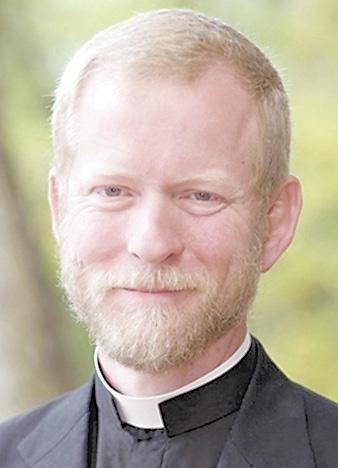
Every state is served by one or more nonprofit organ procurement organizations that work with hospitals to manage organ donations.
HRSA has directed the implicated organ procurement organization to strengthen its patient safeguards and has mandated rigorous corrective actions. These include a root cause analysis of its failure to follow protocols, such as the five-minute observation rule post-death, and the development of clear donor eligibility criteria.
The organ procurement organization must also establish a procedure allowing staff to halt donation if safety concerns arise. Failure to comply risks decertification, a move Kennedy has vowed to enforce.
Father Tad Pacholczyk, a senior ethicist at the NCBC, applauded the new procedure to halt the process due to safety concerns, telling Catholic News Agency that it is “a very sensible safeguard.”
The HHS investigation revealed that some organ procurement organizations actively seek cardiac, or circulatory, death donors rather than brain death ones.
The majority of organ donations come from patients who are determined to have suffered death by neurologic criteria, or brain death, and whose bodies are being sustained mechanically to preserve organ viability. Organ donation following circulatory death, however, has seen significant growth, driven in part by the increased demand for organ transplants and federal pressure on procurement groups.
Unlike brain death, where patients are determined to be in an irreversible state with no brain activity, circulatory death involves patients who are typically comatose and on life support.
These individuals retain some brain function but are deemed unlikely to recover based on medical assessments, which can involve the subjective judgment
of the doctors.
Meaney said there are “question marks” surrounding organ donations that result from the determination of circulatory death, or what he called “cardiac determination,” telling EWTN there is no uniform time clinicians must wait after the heart stops. Hospitals establish the amount of time that can pass before clinicians can determine someone has circulatory death, generally around five minutes.
In some of these cases, Meaney said “the extraction of the organs is actually the cause of death” for the patient.
About 20,000 organs last year were procured after a patient was said to have undergone circulatory death, representing one-third of all donations in the U.S., according to the New York Times. This figure is three times higher than it was five years ago, reflecting a rising reliance on this method.
When families consent to organ donation, once the transplant teams have arrived, the hospital discontinues life support and monitors the patient in the operating room until his or her heart stops. While hospitals oversee patient care until death, once there is cessation of cardiac activity for a sufficient amount of time, specialized surgical teams affiliated with the organ procurement organizations are often brought in to proceed with organ retrieval, which must occur quickly to ensure organs remain suitable for transplantation.
The HRSA investigation found that organ procurement organizations sometimes pressure families and medical staff to expedite the organ retrieval process.
About 170 million Americans are currently listed as organ donors.
Father Pacholczyk told Catholic News Agency, “Many of us would like to become organ donors, but we have questions, even doubts, about whether we can ‘trust the system.’ One of the more widely articulated concerns is whether organs will be taken before patients are properly determined to be deceased, leading many individuals to decide against checking the box on their driver’s license.”
“Given the significant internal and external pressures to procure organs for transplantation today, and given the fact that our society no longer fully esteems the value of every human life, our organ procurement organizations must be subjected to a process of transparent and independent review,” Father Pacholczyk said.

LOS ANGELES — A lineup of Los Angeles business leaders joined Archbishop José H. Gomez July 23 to unveil a new fund aimed at helping families affected by recent immigration raids.
“This program will provide direct support to families who are suffering financial hardships because of the current climate of uncertainty and fear,” said Archbishop Gomez at a press conference at St. Patrick’s Catholic Church near downtown LA.
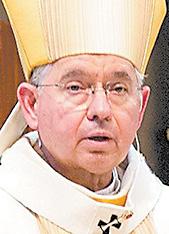
Funds raised by the Archdiocese of LA’s “Family Assistance Program” –believed to be the first of its kind in a U.S. Catholic diocese – will support parish-based outreach ministries that have been delivering groceries, meals, medicine and other essential supplies. Families who need assistance are encouraged to apply by contacting their local parish.
“Our parishes know their people’s needs best, and are therefore leading the effort to distribute aid in the most effective and compassionate way possible,” said Catherine Fraser, the archdiocese’s chief development officer, who added that the program aims to help people regardless of religious affiliation.
Though temporarily halted by a federal judge, weeks of raids by Immigration and Customs Enforcement agents across Southern California have left immigrant communities in LA County on edge.

NEW YORK — Archbishop Gabriele Caccia, permanent observer of the Holy See to the United Nations, delivered a statement at the general debate of the U.N. Economic and Social Council’s High-Level Political Forum July 22, the same day that the Trump administration said the U.S. would withdraw from the United Nations’ cultural agency UNESCO.
Among the agency’s most well-known work is the UNESCO World Heritage Sites program, which recognizes significant historic and cultural landmarks for protection and preservation, including more than two dozen sites in the United States, such as Independence Hall in Philadelphia, the Statue of Liberty in New York and the Grand Canyon in Arizona. Catholic sites and cathedrals, including Vatican City and Notre Dame Cathedral in Paris, are among the World Heritage sites around the globe.
At the forum on sustainable development, Archbishop Caccia said the United Nations’
founding principles “of promoting peace and security, fostering international cooperation, protecting human rights, and advancing social and economic progress for all peoples” are “as vital today as they were eight decades ago, guiding our efforts to address global challenges.”
The archbishop’s comments, however, did not appear to be delivered in response to the administration’s decision to withdraw from UNESCO, a group that has partnered with the Holy See on human development and cultural heritage projects.
WASHINGTON, D.C. — A federal judge on July 21 extended an order blocking enforcement of a provision in the “One Big Beautiful Bill Act,” which President Donald Trump signed into law July 4, that would have stopped Planned Parenthood from receiving Medicaid payments for a year.
U.S. District Judge Indira Talwani in Boston extended her previous order, set to expire the same day, partially granting Planned Parenthood’s request for a preliminary injunction while its lawsuit against the Trump administration proceeds. Talwani’s order appeared to chiefly hinge on making a distinction between Planned Parenthood affiliates that offered abortion and those that did not.
The injunction prohibits the government from defunding 10 Planned Parenthood Federation of America member groups who will not provide abortion services as of Oct. 1, 2025, or whose total direct state and federal reimbursements for Medicaid expenses in fiscal year 2023 did not exceed $800,000, and mandates their funding continue under these conditions.
Marjorie Dannenfelser, president of Susan B. Anthony Pro-Life America, argued in a

statement the order “prolonged the forced taxpayer funding of Big Abortion,” while Planned Parenthood expressed disappointment that only some of its member groups were covered by the order while litigation continued.
WASHINGTON, D.C. — A federal appeals court on July 23 dealt another blow to President Donald Trump’s executive order to end the practice of birthright citizenship as part of a class-action lawsuit.
The U.S. Court of Appeals for the 9th Circuit issued a 2-1 ruling upholding a U.S. District Court’s previous temporary nationwide injunction.
“We conclude that the Executive Order is invalid because it contradicts the plain language of the 14th Amendment’s grant of citizenship to ‘all persons born in the United States and subject to the jurisdiction thereof,’” the ruling said.
The Supreme Court previously limited the ability of federal judges to issue nationwide injunctions in June, but the court indicated such challenges could continue as class-action suits. The ruling may bring the issue back to the Supreme Court as the Trump administration seeks enforcement of its order.
The order is among the Trump administration’s immigration actions that have been met with criticism from the U.S. bishops. Anna Gallagher, executive director of the Catholic Legal Immigration Network, commended the decision in a statement for reaffirming “that birthright citizenship is a fundamental right enshrined in the 14th Amendment of the U.S. Constitution, and it is not within the president’s power to unilaterally change it.”
— OSV News and Catholic News Service
Are you a connector with a hear t for mission and a talent for stor ytelling? Catholic Charities Diocese of Charlotte is seeking a visionar y Exter nal Eng ag ement Director to g row relationships and expand suppor t for our work
In this strategic role, you will eng ag e clerg y, parishioners, donors, volunteers, and community par tners to build awareness and increase res ources. You’ll lead exter nal communications, shape our public voice through media and branding, suppor t fundraising events, and cultivate cor porate sponsorships
Location: Char lotte, NC
Appl y Today
Visit www.ccdoc.or g/car eers for a full job description and application details.
Be part of a team that puts faith into action and brings hope to neighbors in need.
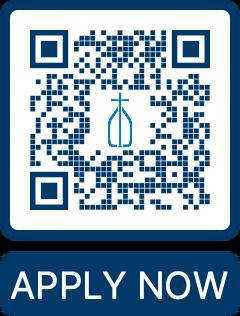
JUDITH SUDILOVSKY OSV News
JERUSALEM — Amid the destruction witnessed during their July 18–20 pastoral visit to Gaza, following the Israeli shelling of the Holy Family Parish church compound that killed three people and injured 10, Cardinal Pierbattista Pizzaballa and Greek Orthodox Patriarch Theophilos III said they found something more enduring – “the dignity of the human spirit.”
“We encountered something deeper than the destruction: the dignity of the human spirit that refuses to be extinguished. We met mothers preparing food for others, nurses treating wounds with gentleness, and people of all faiths still praying to the God who sees and never forgets,” Cardinal Pizzaballa said, reading from a prepared statement.
“Christ is not absent from Gaza. He is there – crucified in the wounded, buried under rubble and yet present in every act of mercy, every candle in the darkness, every hand extended to the suffering.”
The patriarchs described the massive numbers of “starving and hungry-looking people,” they saw stranded along the roads and the long lines of people waiting for food as they traveled to the church compound.
Prices on the black market -– like $100 for 2 pounds of tomatoes – have made basic nutrition unaffordable, worsening health conditions, especially for the elderly and children. “This is really very harsh to the heart,” said Cardinal Pizzaballa.
From his statement he read: “We have seen it: Men holding out in the sun for hours in the hope of a simple meal. This is a humiliation that is hard to bear when you see it with your own eyes. It is morally unacceptable and unjustifiable.”
Patriarch Theophilos called the sight “very sad.”
“We encountered a people crushed by the weight of war, yet carrying within them the image of God. Among the broken walls of the Church of the Holy Family and the wounded hearts of its faithful, we witnessed both profound grief and unyielding hope,” Patriarch Theophilos said, reading from his statement.
He issued a moral appeal to global leaders and communities, warning that remaining silent amid human suffering amounted to a “betrayal of conscience.” He offered words of solidarity to the “children of Gaza,” assuring them that the Church stands with them in their pain.
Addressing those in positions of authority, he invoked a call for peace, reminding them of the biblical teaching: “Blessed are the peacemakers, for they shall be called children of God.”
He said that after returning from Gaza, they held a “very interesting meeting” with U.S. Ambassador to Israel Mike Huckabee to discuss the situation there and rising settler attacks in the West Bank, including in the West Bank village of Taybeh, which the patriarchs visited in a solidarity gesture July 14.
During the press conference, Cardinal Pizzaballa called on U.S. President Donald Trump and other world leaders to be “proactive and to take an important role in order to stop this devastation” to put an end to the 22-month-long war. The war in Gaza broke out after the Oct. 7, 2023, Hamas attack on southern Israeli communities in which 1,200 people were killed and 250 people taken hostage. Fifty people remain in captivity, with 20 people believed to still be alive – some reportedly chained in underground tunnels, according to other hostages who have been released in previous ceasefire agreements.
Cardinal Pizzaballa described a Gaza of almost complete destruction, even more so than when he was last visiting Holy Family Parish just before Christmas. He said that when he visited the neighborhood of the Rosary sisters’ school, he practically could not recognize the area because of the devastation.
He confirmed that although evacuation warnings were

issued, Israel knew those in the Holy Family compound would not leave. About 400 people remain there, and around 160 are sheltering in the Greek Orthodox St. Porphyrios Church compound, he said.
Cardinal Pizzaballa clarified that, contrary to reports from Italian Foreign Minister Antonio Tajani’s X account, the patriarchs did not enter Gaza with 500 tons of aid. They have received Israeli clearance but are coordinating logistics with local partners due to complex conditions. He added that they need time to organize in order to avoid repeating the situation that is happening with distribution of humanitarian aid.
The Israeli-American Gaza Humanitarian Foundation has faced strong criticism after over 1,000 Palestinians were reportedly killed at aid distribution points. While Israel is blamed for the deaths, it claims Hamas gunmen fired into crowds to regain control of aid distribution.

“Humanitarian aid is not only necessary – it is a matter of life and death. Refusing it is not a delay, but a sentence. Every hour without food, water, medicine and shelter causes deep harm,” Cardinal Pizzaballa said in his statement.
He stressed that their mission serves all Gazans, not just one group, noting that church sites such as St. Porphyrios, the Holy Family compound, Al-Ahli Arab Baptist Hospital and Caritas are open to everyone – “Christians, Muslims, believers, doubters, refugees, children.”
The patriarch was audibly moved as he described a scene he witnessed of a father of six sitting beside the hospital bed of his one remaining child.
“Today we raise our voices in an appeal to the leaders of this region and the world: there can be no future based on captivity,
displacement of Palestinians or revenge. There must be a way that restores life, dignity and all lost humanity,” he said.
“It is time to end this nonsense, end the war and put the common good of people as the top priority. We pray – and call – for the release of all those deprived of freedom, for the return of the missing, the hostages and for the healing of long-suffering families on all sides.”
One sight which lifted his spirits was the sight of children still playing despite the devastation around them, he said.
“Children were able to enjoy the small things, ignoring the bombing around them,” he said.
“The building was shaking but they were still playing. You could see how innocent they are. They are our humanity, something of our humanity which remains alive because of them.”
Cardinal Pizzaballa thanked the world Christians for standing beside them and the people of Gaza, emphasizing that they were not against Israel or the Israeli people.
“I think it’s important to say that we are denouncing what is going on in Gaza, but we have also to acknowledge the solidarity of many in … Israeli society. Also thanks to them we could do what we are doing to deliver everything,” he said. “So we are not against Israel, we are not against the Israeli people, but we need to say with frankness and clarity that this policy of the Israeli government in Gaza is unacceptable and morally we cannot justify it. … And the future here is together.”
Standing up to address the patriarchs at the end of the conference, octogenarian Abu-El-Walid Dajani, who belongs to one of the oldest Muslim families of Jerusalem, expressed his “deepest gratitude” on behalf of “many people of the world” for their “courage and thought.”
“We’re looking for a better choice, for a better life in Gaza, and we hope that one day peace will prevail in the Holy Land,” he said.
JERUSALEM — An Israel Defense Forces investigation concluded that a deadly strike on Gaza’s Holy Family Parish compound was caused by an errant mortar round, not an intentional attack. In a July 23 statement, the IDF said the July 17 strike near Gaza City that hit the church building stemmed from “operational activity” and promised tighter guidelines for firing near religious and civilian sites.
Three elderly civilians were killed and 10 wounded in the strike. The IDF expressed “regret” over civilian harm and noted it had approved humanitarian aid deliveries, though the Latin Patriarchate clarified the aid has yet to reach the parish. Cardinal Pierbattista Pizzaballa, visiting Gaza days after the attack, called on world leaders to act decisively to end the 22-month war. “It is time to end this nonsense, end the war and put the common good of people as the top priority.”
VATICAN CITY — Dedicating a Jubilee to Catholic influencers and content creators feels “historic” as the Vatican shows increasing support for digital missionaries and their influence, some participants said.
“We’re called to be apostles of all nations, and that exists also on our phones, on our computers, on our iPads,” said Inés San Martin, vice president of marketing and communications for The Pontifical Mission Societies in the U.S.
San Martin was one of more than 1,000 people from more than 70 countries registered for the Jubilee of Digital Missionaries and Catholic Influencers July 28-29.
Katie Prejean McGrady, author, podcaster and radio host on Sirius XM’s The Catholic Channel, said it is “so cool that the church is acknowledging that this is a group of people doing a real thing and a real ministry in the world” by hosting a dedicated Jubilee. “I think in a hundred years, people are going to talk about the Jubilee of 2025 and how this was the first time the church engaged with this group of missionaries,” she said.
— OSV News and Catholic News Service

Faith guides your life, why not your financial decisions?
For over 140 years, the Knights of Columbus has been committed to helping families plan their nancial future and achieve economic security, a tradition carried on today through its insurance products.
Book a complimentary financial needs analysis today.



Join a mission-driven team that’s shaping how the Diocese of Charlotte connects, informs and inspires –in one of the nation’s fastest-growing regions.
We’re seeking a bilingual Communications Assistant to provide essential editorial and administrative support for the award-winning Catholic News Herald and diocesan channels and produce content highlighting our parishes, schools and ministries. You’ll also assist with media outreach and help build relationships and audiences. Candidates should have at least 2 years’ experience as an editorial or office administrative assistant (or similar), an associate’s degree or higher, and fluency in written and spoken
If you’re detail-oriented, organized and ready



Is laughter good medicine? Maybe, but it’s rare that we hear about the laughter of a saint. In our current historical moment, I think we need a saint’s laughter. In July we celebrated 31 days of St. Ignatius of Loyola, leading up to the anniversary of his death July 31, 1556.
Originally a soldier, St. Ignatius founded the Society of Jesus (Jesuits) and became one of our greatest saints.
But in all the reading I’ve done on Ignatius I’d never heard about laughter. So, reading a book of selected works by and about Ignatius, I came across this line, written by his companion and first-generation Jesuit, Jeronimo Nadal: “Those who were in his room,” wrote Nadal, “were continually laughing.”
Hearing that Ignatius’ rooms were full of laughter is a good reminder at a time when so many Americans are feeling anxious. We are, after all, in a Jubilee Year of hope.
Recently, I read about a man who appeared at immigration court, accompanied by two Jesuits and a religious sister. He was following the legal process of seeking asylum but was whisked off by masked people purporting to be ICE employees.
The responses to the post were intense. “I live every day in a state of outrage and grief,” wrote one poster. “I am very distraught,” wrote another. Posts continued to pour out deep angst.
None of this, of course, is a laughing matter. Yet when we find ourselves distraught and grieving, we remember that, as Christians, we’re called to hope and to joy. Ignatius, too, lived in tumultuous times. The Protestant Reformation roiled Europe. Plague swept through cities intermittently. Henry VIII abandoned the Church for a second marriage.
Somehow, Ignatius, who called himself “the pilgrim,” kept his eyes on God. I remind myself that we pilgrims of hope cannot solve all the world’s problems. We aid our neighbors when and where we can. We remain active politically. We avoid obsessing over the news. We focus on the positive, the helpers, the good around us.
Notice Nadal refers to “those who were in his room.” We seldom laugh robustly by ourselves. Laughter is a communal event, something we do best together. Community has never been more important than it is right now.
EFFIE CALDAROLA is a wife, mom and grandmother who received her master’s degree in pastoral studies from Seattle University.
We proclaim Christ to the world around us by our efforts to provide a safe environment for all people, especially the young and the vulnerable.

The Catholic Church is absolutely committed to the safety of children. Together we can make a Promise to Protect and a Pledge to Heal.
Suspect sexual abuse or misconduct?
If you have information about possible sexual abuse or misconduct by any clergy, employee or volunteer of the Diocese of Charlotte, report concerns safely, securely and anonymously 24/7 over the phone using the diocese’s new hotline, 1-888-630-5929, or online: www.RedFlagReporting.com/RCDOC
Please note: If you suspect a child is in danger, please contact 9-1-1 or your local law enforcement agency.
Safe Environment training
Every Church worker must go through abuse prevention and education training. Find more information about the Diocese of Charlotte’s Safe Environment program, sign up for Protecting God’s Children training and more: Go to www.charlottediocese.org and click on “Safe Environment”
For more information or questions, please contact the diocese’s Safe Environment Office: www.safeenvironment@rcdoc.org or 704-370-3222

We are our brothers’
A Catholic critique of ‘The Let Them Theory’
What if all that is holding you back from achieving your wildest dreams is yourself? This question has been the topic of many a self-help book and rests at the center of a book that has been on the New York Times bestseller list for 30 weeks, “The Let Them Theory.”
Let Them Theory is the brainchild of Mel Robbins, a self-help author and secular inspirational speaker. Her book on the theory has sold more than 5 million copies since it was published in late 2024.
Beyond just the book, Let Them Theory has become the topic of podcast episodes and viral social media videos, and it has been promoted by corporate businesspeople and psychotherapists.
The theory has two parts which together, the author claims, will lead to inner peace and personal success. First, when someone else does something that bothers you, say, “Let them.”
Whether it is a child who is moving away from the faith, a co-worker who watches your every move, or a government that has turned on its citizens, Robbins tells readers that the actions of others are outside their control. Life isn’t fair, and the sooner you can accept that, the sooner you will be at peace, she says. Let go of control, honor the autonomy of others, and say, “Let them.”
The second part of the theory is what Robbins calls, “Let me.” After letting go of the actions of others, readers are encouraged to ask themselves what they can do to change the situation. It is true that you cannot control what a co-worker thinks, but you can leave your job. You cannot control what your government does, but you can control where you live and who you vote for. “Let me” is the component of the theory that is supposed to move readers from inner peace to self-actualization of the life they desire.
‘LET THEM’: WRONG ANSWER TO EVIL
The Let Them Theory is attractive for many reasons, most especially its promise of internal peace. It is reminiscent of prayers like the Serenity Prayer or the Litany of Humility, asking God for the grace not to be consumed by what others think of you and to let go of things that are outside of your control.
“Let them” is an act of surrender to the will of God, it may seem, while “let me” is an act of empowerment.
While parts of “The Let Them Theory” may seem compatible with the Christian life, it is extremely problematic at its core.
The purpose of the theory, as it is proposed by Robbins, is to achieve personal success, and the examples she gives mostly revolve around bruised egos, carefully avoiding addressing real evils that exist in the world.
The peace that Jesus came to give comes from Him alone, not from detaching from love of others. To achieve internal peace by simply saying, “Let them,” in the face of real evil and suffering is an ersatz peace, a manufactured peace from the Evil One. It suggests that the solution to relationship problems is to ignore what you don’t like in your spouse, family member or neighbor, rather than learning to love them as Jesus does, warts and all.
Learning to say “Let them” when a troll comments on a social media post is one thing. Saying “Let them” in the face of the abominations of abortion, war, racism and the other evils in our world is a detachment that may lead to a feeling of peace, but it will end up killing our brothers and sisters in body and soul. If this is what is required to achieve success, as Robbins claims, it is a material and worldly success, not a life measured by grace and holiness.
A Christian counter-practice to the Let Them Theory is the age-old practice of “memento mori,” or “remember your death.” When you keep eternity in mind, everything is kept in proper perspective, because the end goal is not wealth or being unbothered, but total communion with God.
Unlike the Let Them Theory, “memento mori” helps to develop a conscience that is bothered by sin and evil, and is moved to act for love of God and love of neighbor rather than simple peace of mind.
The saints did not see their brothers and sisters suffering and say, “Let them.” No, they were prophetic, countercultural voices who loved the poor and the outcast. They spoke up rather than remain silent, even when it came at great personal cost. The Let Them Theory has been successful because it speaks to the human desire to not be bothered or consumed by the horrors of a fallen world, which is certainly understandable. But ultimately it is a cheap way out of accepting the foolishness of the Cross and learning to love with the heart of Christ.
CECILIA CICONE is an author and communicator who works in diocesan ministry in Northwest Indiana.

Two more states have recently fallen into the death trap. Delaware recently became the 12th state and New York may be the 13th state to legalize what used to be called physician-assisted suicide but is increasingly called medical aid in dying. New York’s legislature has passed their legislation, so at this time, the bill only needs the governor’s signature.
‘We need to broaden the pro-life lens to include the entire span of life by accepting our Catholic social teaching in stressing the importance of promoting integral human development.’
According to Compassion and Choices, a death-supporting advocacy organization, there are now 16 other states that have active legislation to help people kill themselves. If those are successful, a majority of states in our country will have made it legal for a person to request drugs from their physician to end their life.
The arguments developed to defend legal killing of children through abortion have now been adopted and modified to support the offer of death to the elderly, infirm or disabled. Self-murder is defended as an inviolate and sacred right to be protected as one’s personal choice – absent interference from loved ones or doctors. Passive euthanasia, the kind of “mercy killing” they have in the Netherlands and Canada where an individual gives their consent for their doctor to kill them, isn’t legal in any U.S. state.
At least, not yet.
SOME PHYSICIANS ADVOCATE FOR DEATH
No one is being compelled anywhere by law to kill themselves. So far, that is something that only happens in dystopian books and movies, but there is a fine line between compulsion and coercion. That line is often blurred by the compelling influence of shifting cultural mores and by health care professionals who tend to patients in medical or existential crisis, including some who advocate strongly for death.
After the New York legislature passed its
medical aid in dying (MAID) bill in June, the Journal of Medical Ethics published a piece called “Physicians’ preferences for their own end of life: a comparison across North America, Europe, and Australia.” The report showed that “about half of the physicians who responded considered euthanasia a (very) good option.”
The good news, I guess, is that only 37.4 percent in Georgia considered it a good option.
The question asked, in the situation of a terminal cancer diagnosis, about euthanasia, not physician-assisted suicide – i.e., they asked about doctors killing patients rather than doctors giving drugs to patients so they could kill themselves. Those numbers change when the question of physician-assisted suicide (PAS) is presented: 43.9 percent of doctors in Georgia approve and 71.2 percent of physicians had a personal preference for PAS in Oregon, the first state to pass legislation allowing it.
Physician-assisted suicide has become socially acceptable – even desirable – in the U.S. The death train is long out of the station and making its grand tour into each of our states with foul, black smoke belching out from its stack. How do we stop it?
Death is winning by shifting cultural mores and by a medical profession that largely favors it. I will make two broad suggestions.
First, we need to reclaim our educational institutions, including medical schools. Happily, Benedictine College in Atchison, Kansas, has announced its intent to establish a faithfully Catholic medical school that would “enshrine Catholic moral teaching on the infinite dignity of the human person as created by God.” Pray for its success.
Second, we need to broaden the pro-life lens to include the entire span of life by accepting our Catholic social teaching in stressing the importance of promoting integral human development: the protection and support of life throughout the lifespan.
Focusing on the beginning and end isn’t sufficient for a culture that has lost its basic understanding of human dignity and the immeasurable value of all human life. Of course, there is no substitute for prayer and fasting. Each of us can take up that discipline as a strong weapon to defeat the enemies of life. We have to change the culture of death closing in on us just as the first disciples of Jesus did – by the power of their prayers and the witness of their lives.
MARK BRADFORD is Fellow for Persons with Intellectual and Developmental Disabilities at Word on Fire Institute and an advocate for those born with intellectual and developmental disabilities and their families. This is excerpted from an essay at www.wordonfire.org.

Most-read stories on the web
‘I hope that this will be an opportunity for each of you to encounter Christ, and to be strengthened by Him in your faith and in your commitment to following Christ with integrity of life.’
Pope Leo XIV
From online story: “Pope welcomes young people to Rome for jubilee, thanks media for promoting truth”

The Catholic News Herald reached the Facebook and Instagram feeds of more than 915,000 people in English and Spanish last month. The most talked about post? Coverage of the Mass of Hope for the Jubilee Year from High Point. Join the conversation: www. facebook.com/CatholicNewsHerald
On YouTube over the past 30 days ending July 30, videos produced by the Catholic News Herald have been viewed more than 8,000 times. The most popular video? Coverage of our newest priests.
Over the past 30 days ending July 30, 25,000 visitors to www.catholicnewsherald.com have viewed a total of 50,000 pages. The top trending headlines are:
n 2025 priest assignments announced 4,390
n Diocese weighs $150M initiative to help meet parish needs, slows cathedral project...... 1,821
n Experience your own Camino on the first Carolina Camino Pilgrimage 978
n Three Franciscans launch unique outreach with Charlotte diocese ........................................ 858
n Priests move into new roles across diocese 762
Join the conversation online

The Catholic News Herald welcomes letters from readers. We ask that letters be originals of 250 words or fewer, pertain to recent newspaper content or Catholic issues, and be written from a perspective of Christian charity.
To be considered for publication, each letter must include the name, address and daytime phone number of the writer for purpose of verification. Letters may be condensed due to space limitations and edited for clarity, style and factual accuracy.



@CatholicNewsCLT Pinterest.com/ charlottecnh Catholicnewsclt facebook.com/ catholic newsherald Diocese of Charlotte
The Catholic News Herald does not publish poetry, form letters or petitions. Items submitted to The Catholic News Herald become the property of the newspaper and are subject to reuse, in whole or in part, in print, electronic formats and archives.
E-mail: catholicnews@rcdoc.org
Mail: Letters to the Editor Catholic News Herald 1123 S. Church St. Charlotte, N.C. 28203
Friday-Saturday, Sept. 5-6 | Charlotte Convention Center | FREE


In a world losing itself to screens, teenage mystic Carlo Acutis saw beyond our social media-addicted society and offered an answer – if we’re willing to listen.
